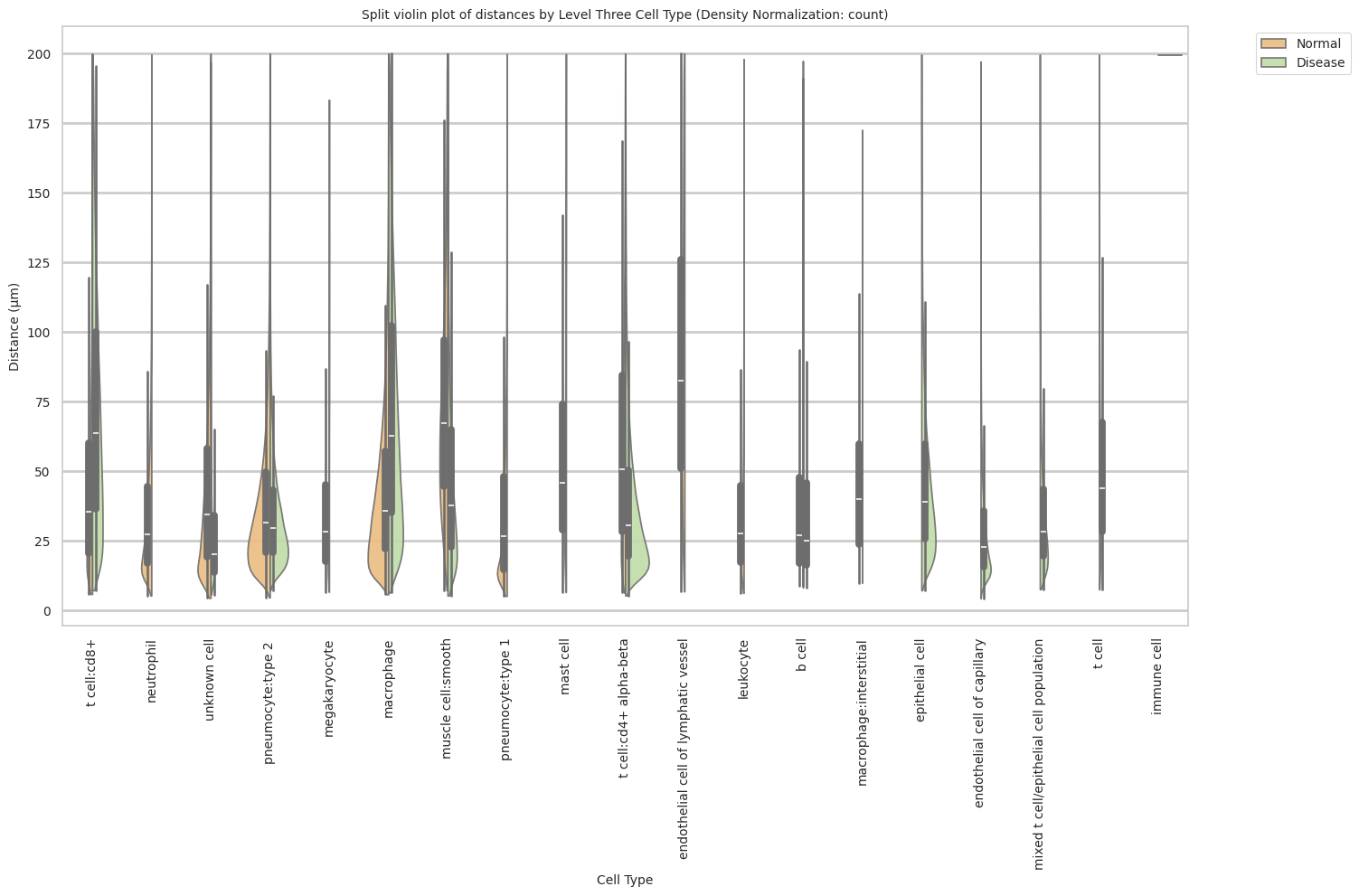import numpy as np
import pandas as pd
import os
import json
import requests
import shutil
import matplotlib.pyplot as plt
import seaborn as sns
from sklearn.preprocessing import normalize
import plotly.express as px
from _cde_compute_edges_from_nodes import *
pd.set_option('display.max_columns', None)
pd.set_option('display.max_rows', None)
# suppress warnings
import warnings
warnings.filterwarnings("ignore")Distance Analysis: lung-codex-urmc
Analyze and visualize cell-to-nearest-endothelial-cell distance distributions for the
lung-codex-urmc dataset.
basepath = "/u/yashjain/hra-cell-distance-analysis/data"
dataset_dir = "lung-codex-urmc"
data_filedir = os.path.join("data-processed-nodes-with-harmonized-cell-types", dataset_dir)
output_edge_dir = os.path.join("data-processed-edges", dataset_dir)
figures_output_dir = "generated-figures"# Function to load your data
def load_data(path, edges=False):
if edges:
column_names = ['cell_id', 'x1', 'y1', 'z1', 'x2', 'y2', 'z2']
data = pd.read_csv(path, header=None, names=column_names)
else:
data = pd.read_csv(path)
return data# Function to read all files ending with "-nodes.csv" in the `data_filedir` directory into a single DataFrame.
# Another additional column `Dataset` is added to identify the dataset name which comes from the filename before the `-nodes.csv` suffix.
# Additionally, function reads all files ending with "-edges.csv" in the `output_edge_dir` directory into a single DataFrame.
# Three additional columns are added "Dataset", "Anchor Cell Type", and "Anchor Cell Type Level" to identify the dataset name, anchor cell type, and anchor cell type level respectively which come from the filename before the `.csv` suffix.
# The three additional columns are created by splitting the filename on the `-` character, and extracting the relevant parts.
# On splitting, the first part is the dataset name, second part is the anchor cell type level, and third part is the anchor cell type, and last part is the `edges` suffix.
# When reading files, check if the file has the correct format (i.e., ends with `-edges.csv`).
# Additionally, the function merges the edges DataFrame with the nodes DataFrame to get the cell type information for the anchor cells.
# This is done by reading the corresponding nodes file from the `data_filedir` directory for each edges file, and merging it with the edges DataFrame on the `cell_id` column.
# The merged DataFrame contains the edges with additional columns for the cell type information.
# The function returns three DataFrames:
# 1. `merged_nodes`: DataFrame containing all nodes with an additional column `Dataset`.
# 2. `merged_edges`: DataFrame containing all edges with additional columns `Dataset`, `Anchor Cell Type`, and `Anchor Cell Type Level`.
# 3. `merged_nodes_for_all_edges`: DataFrame containing all edges with additional columns `Dataset`, `Anchor Cell Type`, `Anchor Cell Type Level`, and the cell type information for cells.
def read_all_edge_datasets(basepath, data_filedir, output_edge_dir):
all_nodes_files = []
all_edges_files = []
all_nodes_edges_files = []
for file in os.listdir(os.path.join(basepath, output_edge_dir)):
if file.endswith("-edges.csv"):
file_path = os.path.join(basepath, output_edge_dir, file)
d1, d2, d3, d4, anchor_cell_type_level, anchor_cell_type = file.replace("-edges.csv", "").split('-')
dataset_name = f'{d1}-{d2}-{d3}-{d4}' # Construct dataset name from the first four parts of the filename.
edges_df = load_data(file_path, edges=False)
edges_df['Dataset'] = dataset_name
edges_df['Anchor Cell Type'] = anchor_cell_type
edges_df['Anchor Cell Type Level'] = anchor_cell_type_level
edges_df.rename(columns={"distance": "Distance"}, inplace=True) # Rename column "distance" to "Distance".
all_edges_files.append(edges_df)
# Read the corresponding nodes file from data_filedir to get the cell type information
nodes_file_path = os.path.join(basepath, data_filedir, f"{dataset_name}-nodes.csv")
nodes_df = load_data(nodes_file_path)
nodes_df['Dataset'] = dataset_name
all_nodes_files.append(nodes_df)
# Add a new 'cell_id' column to nodes_df
nodes_df['cell_id'] = range(len(nodes_df))
# Set 'cell_id' column as index for nodes_df
nodes_df.set_index('cell_id', inplace=True)
# Merge edges_df with nodes_df to get the cell type information for the anchor cells
edges_nodes_df = pd.merge(edges_df, nodes_df[['Level Three Cell Type', 'Level Two Cell Type', 'Level One Cell Type']], how='left', left_on='cell_id', right_index=True)
all_nodes_edges_files.append(edges_nodes_df)
merged_edges = pd.concat(all_edges_files, ignore_index=True)
merged_nodes = pd.concat(all_nodes_files, ignore_index=True)
merged_nodes_for_all_edges = pd.concat(all_nodes_edges_files, ignore_index=True)
return merged_nodes, merged_edges, merged_nodes_for_all_edgesdef create_directory(directory):
if not os.path.exists(directory):
os.makedirs(directory)
print(f"Directory '{directory}' created successfully.")
else:
print(f"Directory '{directory}' already exists.")Get initial statistics and identify endothelial cell categories for dataset.
df_all_nodes, df_all_edges, df_all_edges_with_cell_types = read_all_edge_datasets(basepath, data_filedir, output_edge_dir)df_all_nodes.head(5)| x | y | Original Cell Type | Level Three Cell Type | Level Three CL Label | Level Three CL ID | CL_Match/3 | Level Two Cell Type | Level Two CL Label | Level Two CL ID | CL_Match/2 | Level One Cell Type | Level One CL Label | Level One CL ID | CL_Match/1 | Dataset | |
|---|---|---|---|---|---|---|---|---|---|---|---|---|---|---|---|---|
| 0 | 55.000000 | 4633.074074 | CD8 + T cell_1 | t cell:cd8+ | lung resident memory CD8-positive, alpha-beta ... | CL:4033039 | skos:exactMatch | t cell | T cell | CL:0000084 | skos:exactMatch | immune cell | leukocyte | CL:0000738 | skos:exactMatch | D265-LLL-7A7-12 |
| 1 | 794.777778 | 3643.197531 | CD8 + T cell_1 | t cell:cd8+ | lung resident memory CD8-positive, alpha-beta ... | CL:4033039 | skos:exactMatch | t cell | T cell | CL:0000084 | skos:exactMatch | immune cell | leukocyte | CL:0000738 | skos:exactMatch | D265-LLL-7A7-12 |
| 2 | 848.313953 | 3606.447674 | CD8 + T cell_1 | t cell:cd8+ | lung resident memory CD8-positive, alpha-beta ... | CL:4033039 | skos:exactMatch | t cell | T cell | CL:0000084 | skos:exactMatch | immune cell | leukocyte | CL:0000738 | skos:exactMatch | D265-LLL-7A7-12 |
| 3 | 1046.877061 | 2890.736132 | CD8 + T cell_1 | t cell:cd8+ | lung resident memory CD8-positive, alpha-beta ... | CL:4033039 | skos:exactMatch | t cell | T cell | CL:0000084 | skos:exactMatch | immune cell | leukocyte | CL:0000738 | skos:exactMatch | D265-LLL-7A7-12 |
| 4 | 2406.666667 | 1298.307692 | CD8 + T cell_1 | t cell:cd8+ | lung resident memory CD8-positive, alpha-beta ... | CL:4033039 | skos:exactMatch | t cell | T cell | CL:0000084 | skos:exactMatch | immune cell | leukocyte | CL:0000738 | skos:exactMatch | D265-LLL-7A7-12 |
# Print the total number of unique cell types per dataset. Compute separately for each cell type column (Level One Cell Type, Level Two Cell Type, Level Three Cell Type, Original Cell Type).
print("Total number of unique cell types per cell type annnotation level:")
unique_cell_types = {
'Original Cell Type': df_all_nodes['Original Cell Type'].nunique(),
'Level Three Cell Type': df_all_nodes['Level Three Cell Type'].nunique(),
'Level Two Cell Type': df_all_nodes['Level Two Cell Type'].nunique(),
'Level One Cell Type': df_all_nodes['Level One Cell Type'].nunique()
}
for cell_type, count in unique_cell_types.items():
print(f"{cell_type}: {count}")Total number of unique cell types per cell type annnotation level:
Original Cell Type: 54
Level Three Cell Type: 20
Level Two Cell Type: 17
Level One Cell Type: 7# Save the unique cell types containing "endothelial" in name per cell type column (Level One Cell Type, Level Two Cell Type, Level Three Cell Type, Original Cell Type) to a dictionary where the key is the level and the value is a list of unique cell types.
endothelial_cell_types = {
'Original Cell Type': df_all_nodes[df_all_nodes['Original Cell Type'].str.contains("endothelial", case=False, na=False)]['Original Cell Type'].unique().tolist(),
'Level Three Cell Type': df_all_nodes[df_all_nodes['Level Three Cell Type'].str.contains("endothelial", case=False, na=False)]['Level Three Cell Type'].unique().tolist(),
'Level Two Cell Type': df_all_nodes[df_all_nodes['Level Two Cell Type'].str.contains("endothelial", case=False, na=False)]['Level Two Cell Type'].unique().tolist(),
'Level One Cell Type': df_all_nodes[df_all_nodes['Level One Cell Type'].str.contains("endothelial", case=False, na=False)]['Level One Cell Type'].unique().tolist()
}
print("\nEndothelial cell types per cell type annotation level:")
for level, cell_types in endothelial_cell_types.items():
print(f"\n{level}:")
for cell in cell_types:
print(f" - {cell}")
Endothelial cell types per cell type annotation level:
Original Cell Type:
Level Three Cell Type:
- endothelial cell
- endothelial cell of lymphatic vessel
- endothelial cell of capillary
Level Two Cell Type:
- endothelial cell
- endothelial cell of lymphatic vessel
- endothelial cell of capillary
Level One Cell Type:
- endothelial celltype_field_list = ["Level Three Cell Type", "Level Two Cell Type", "Level One Cell Type"] # Skipping Original Cell Type as it is not a hierarchical level.
# Define the anchor cell type (type of endothelial cell) for each level in type_field_list based on available categories in the previous cell. The distance analysis at all three levels will be limited to the specified anchor cell type.
anchor_cell_type_dict = {
'Level Three Cell Type': 'endothelial cell',
'Level Two Cell Type': 'endothelial cell',
'Level One Cell Type': 'endothelial cell'
}Process datasets to add region information to Nodes files.
# Create a dictionary to map lung regions to correct Normal/Disease condition.
region_map = {'D115-RLL-10A3-40':'Disease',
'D265-LLL-7A7-12':'Normal',
}
# Define the standard region sequence for plots
regions = ['Normal', 'Disease']df_all_nodes.head()| x | y | Original Cell Type | Level Three Cell Type | Level Three CL Label | Level Three CL ID | CL_Match/3 | Level Two Cell Type | Level Two CL Label | Level Two CL ID | CL_Match/2 | Level One Cell Type | Level One CL Label | Level One CL ID | CL_Match/1 | Dataset | |
|---|---|---|---|---|---|---|---|---|---|---|---|---|---|---|---|---|
| 0 | 55.000000 | 4633.074074 | CD8 + T cell_1 | t cell:cd8+ | lung resident memory CD8-positive, alpha-beta ... | CL:4033039 | skos:exactMatch | t cell | T cell | CL:0000084 | skos:exactMatch | immune cell | leukocyte | CL:0000738 | skos:exactMatch | D265-LLL-7A7-12 |
| 1 | 794.777778 | 3643.197531 | CD8 + T cell_1 | t cell:cd8+ | lung resident memory CD8-positive, alpha-beta ... | CL:4033039 | skos:exactMatch | t cell | T cell | CL:0000084 | skos:exactMatch | immune cell | leukocyte | CL:0000738 | skos:exactMatch | D265-LLL-7A7-12 |
| 2 | 848.313953 | 3606.447674 | CD8 + T cell_1 | t cell:cd8+ | lung resident memory CD8-positive, alpha-beta ... | CL:4033039 | skos:exactMatch | t cell | T cell | CL:0000084 | skos:exactMatch | immune cell | leukocyte | CL:0000738 | skos:exactMatch | D265-LLL-7A7-12 |
| 3 | 1046.877061 | 2890.736132 | CD8 + T cell_1 | t cell:cd8+ | lung resident memory CD8-positive, alpha-beta ... | CL:4033039 | skos:exactMatch | t cell | T cell | CL:0000084 | skos:exactMatch | immune cell | leukocyte | CL:0000738 | skos:exactMatch | D265-LLL-7A7-12 |
| 4 | 2406.666667 | 1298.307692 | CD8 + T cell_1 | t cell:cd8+ | lung resident memory CD8-positive, alpha-beta ... | CL:4033039 | skos:exactMatch | t cell | T cell | CL:0000084 | skos:exactMatch | immune cell | leukocyte | CL:0000738 | skos:exactMatch | D265-LLL-7A7-12 |
# Iterate through the df_all_data dataframe to create new column "Unique Region" based on the "Dataset" column.
# The "Unique Region" column is created by mapping the region names based on the full dataset name.
df_all_nodes['Unique Region'] = df_all_nodes['Dataset'].map(region_map)
# df_all_nodes['Unique Region'] = df_all_nodes['Dataset'].str.split('-').str[1].map(region_map)
# Check if the new columns are created correctly.
df_all_nodes[['Dataset', 'Unique Region']].head(5)| Dataset | Unique Region | |
|---|---|---|
| 0 | D265-LLL-7A7-12 | Normal |
| 1 | D265-LLL-7A7-12 | Normal |
| 2 | D265-LLL-7A7-12 | Normal |
| 3 | D265-LLL-7A7-12 | Normal |
| 4 | D265-LLL-7A7-12 | Normal |
# Print all unique regions in the data.
print("\nUnique Regions in the data:")
print(df_all_nodes['Unique Region'].unique())
# Print the total number of unique regions.
print(f"Total number of unique regions: {df_all_nodes['Unique Region'].nunique()}")
# Print number of unique datasets per unique region.
print("\nNumber of unique datasets per unique region:")
for region in df_all_nodes['Unique Region'].unique():
num_datasets = df_all_nodes[df_all_nodes['Unique Region'] == region]['Dataset'].nunique()
print(f"{region}: {num_datasets}")
Unique Regions in the data:
['Normal' 'Disease']
Total number of unique regions: 2
Number of unique datasets per unique region:
Normal: 1
Disease: 1Process datasets to add region information to Edges files.
df_all_edges.head(5)| cell_id | x1 | y1 | z1 | x2 | y2 | z2 | Distance | Dataset | Anchor Cell Type | Anchor Cell Type Level | |
|---|---|---|---|---|---|---|---|---|---|---|---|
| 0 | 9600 | 54.891304 | 14218.369565 | 0 | 164.375000 | 14329.000000 | 0 | 155.646306 | D265-LLL-7A7-12 | endothelial cell | Level Three Cell Type |
| 1 | 9604 | 148.519685 | 14344.433071 | 0 | 164.375000 | 14329.000000 | 0 | 22.126244 | D265-LLL-7A7-12 | endothelial cell | Level Three Cell Type |
| 2 | 9603 | 145.042553 | 13454.680851 | 0 | 150.838235 | 13477.191176 | 0 | 23.244455 | D265-LLL-7A7-12 | endothelial cell | Level Three Cell Type |
| 3 | 9605 | 151.107143 | 13463.553571 | 0 | 150.838235 | 13477.191176 | 0 | 13.640256 | D265-LLL-7A7-12 | endothelial cell | Level Three Cell Type |
| 4 | 9607 | 160.127168 | 13502.421965 | 0 | 150.838235 | 13477.191176 | 0 | 26.886371 | D265-LLL-7A7-12 | endothelial cell | Level Three Cell Type |
# Process the edge data to create new columns "Unique Region" based on the "Dataset" column, similar to how it was done for the node data.
df_all_edges['Unique Region'] = df_all_edges['Dataset'].map(region_map)
# Check if the new columns are created correctly.
df_all_edges[['Dataset', 'Unique Region']].head(5)| Dataset | Unique Region | |
|---|---|---|
| 0 | D265-LLL-7A7-12 | Normal |
| 1 | D265-LLL-7A7-12 | Normal |
| 2 | D265-LLL-7A7-12 | Normal |
| 3 | D265-LLL-7A7-12 | Normal |
| 4 | D265-LLL-7A7-12 | Normal |
# Print all unique regions in the data.
print("\nUnique Regions in the data:")
print(df_all_edges['Unique Region'].unique())
# Print the total number of unique regions.
print(f"Total number of unique regions: {df_all_edges['Unique Region'].nunique()}")
# Print number of unique datasets per unique region.
print("\nNumber of unique datasets per unique region:")
for region in df_all_edges['Unique Region'].unique():
num_datasets = df_all_edges[df_all_edges['Unique Region'] == region]['Dataset'].nunique()
print(f"{region}: {num_datasets}")
Unique Regions in the data:
['Normal' 'Disease']
Total number of unique regions: 2
Number of unique datasets per unique region:
Normal: 1
Disease: 1df_all_edges_with_cell_types['Unique Region'] = df_all_edges_with_cell_types['Dataset'].map(region_map)
# Check if the new columns are created correctly.
df_all_edges_with_cell_types[['Dataset', 'Unique Region']].head(5)| Dataset | Unique Region | |
|---|---|---|
| 0 | D265-LLL-7A7-12 | Normal |
| 1 | D265-LLL-7A7-12 | Normal |
| 2 | D265-LLL-7A7-12 | Normal |
| 3 | D265-LLL-7A7-12 | Normal |
| 4 | D265-LLL-7A7-12 | Normal |
df_all_nodes.head(1)| x | y | Original Cell Type | Level Three Cell Type | Level Three CL Label | Level Three CL ID | CL_Match/3 | Level Two Cell Type | Level Two CL Label | Level Two CL ID | CL_Match/2 | Level One Cell Type | Level One CL Label | Level One CL ID | CL_Match/1 | Dataset | Unique Region | |
|---|---|---|---|---|---|---|---|---|---|---|---|---|---|---|---|---|---|
| 0 | 55.0 | 4633.074074 | CD8 + T cell_1 | t cell:cd8+ | lung resident memory CD8-positive, alpha-beta ... | CL:4033039 | skos:exactMatch | t cell | T cell | CL:0000084 | skos:exactMatch | immune cell | leukocyte | CL:0000738 | skos:exactMatch | D265-LLL-7A7-12 | Normal |
df_all_edges.head(1)| cell_id | x1 | y1 | z1 | x2 | y2 | z2 | Distance | Dataset | Anchor Cell Type | Anchor Cell Type Level | Unique Region | |
|---|---|---|---|---|---|---|---|---|---|---|---|---|
| 0 | 9600 | 54.891304 | 14218.369565 | 0 | 164.375 | 14329.0 | 0 | 155.646306 | D265-LLL-7A7-12 | endothelial cell | Level Three Cell Type | Normal |
df_all_edges_with_cell_types.head(1)| cell_id | x1 | y1 | z1 | x2 | y2 | z2 | Distance | Dataset | Anchor Cell Type | Anchor Cell Type Level | Level Three Cell Type | Level Two Cell Type | Level One Cell Type | Unique Region | |
|---|---|---|---|---|---|---|---|---|---|---|---|---|---|---|---|
| 0 | 9600 | 54.891304 | 14218.369565 | 0 | 164.375 | 14329.0 | 0 | 155.646306 | D265-LLL-7A7-12 | endothelial cell | Level Three Cell Type | t cell:cd8+ | t cell | immune cell | Normal |
Node Analysis
# Plot number of cells per cell type in the same plot. Color by cell type and unique region. Output figure saved in existing `figures_output_dir`.
def plot_cells_per_celltype(df, type_field, output_dir):
plt.figure(figsize=(20, 8))
plt.rcParams["svg.fonttype"] = 'none' # to store text as text, not as path
sns.countplot(data=df, x=type_field, palette='Spectral', hue='Unique Region')
plt.title(f'Number of Cells per {type_field} in `{dataset_dir}`')
plt.xticks(rotation=90)
plt.tight_layout()
plt.savefig(os.path.join(output_dir, f'{dataset_dir}_cells_per_celltype_{type_field}.png'), dpi=300,
bbox_inches='tight',
pad_inches=0.5)
plt.savefig(os.path.join(output_dir, f'{dataset_dir}_cells_per_celltype_{type_field}.svg'), dpi=300,
bbox_inches='tight',
pad_inches=0.5)
plt.legend(title='Unique Region', bbox_to_anchor=(0.85, 1), loc='upper left')
plt.xlabel(type_field)
# For numbers on y-axis, do not use scientific notation.
plt.ticklabel_format(style='plain', axis='y')
# Set y-axis label
plt.ylabel('Number of Cells')
plt.grid(axis='y', linestyle='--', alpha=0.7)
plt.tight_layout()
# Show the plot
plt.show()
plt.close()
for type_field in type_field_list:
plot_cells_per_celltype(df_all_nodes, type_field, os.path.join(basepath, figures_output_dir))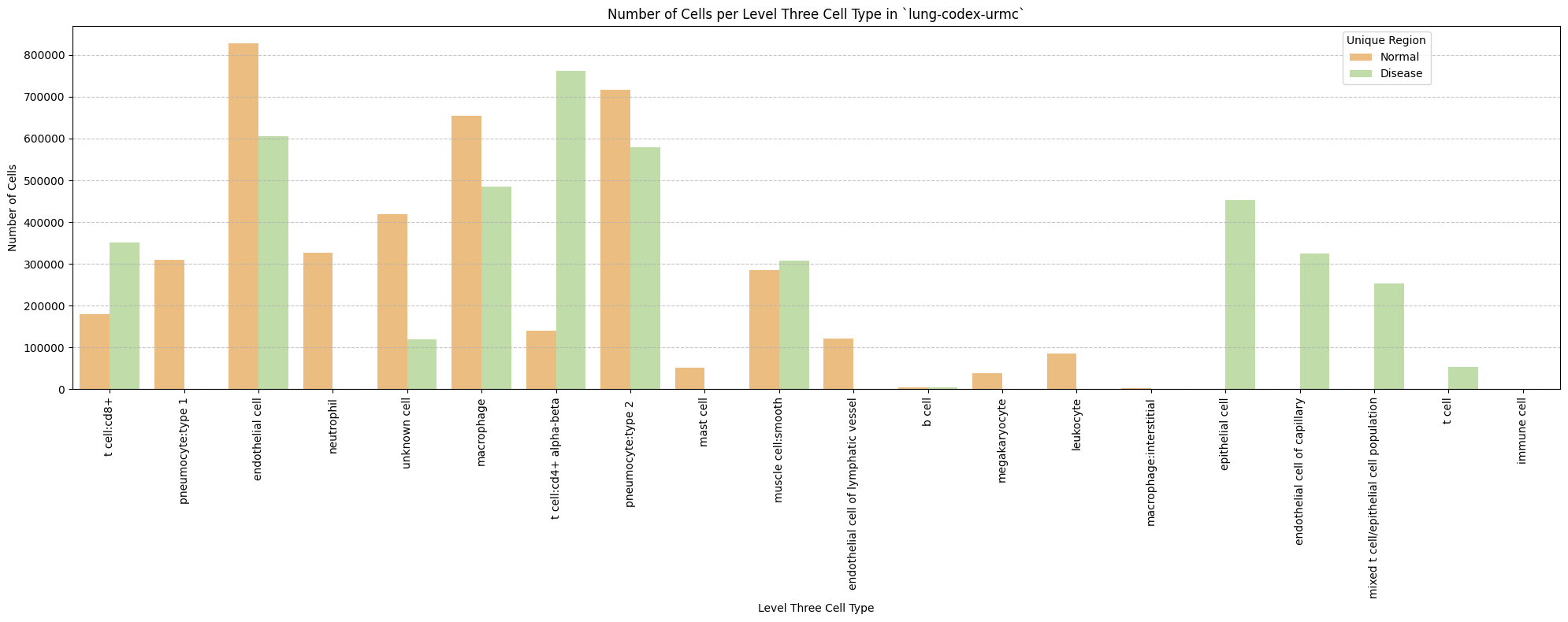
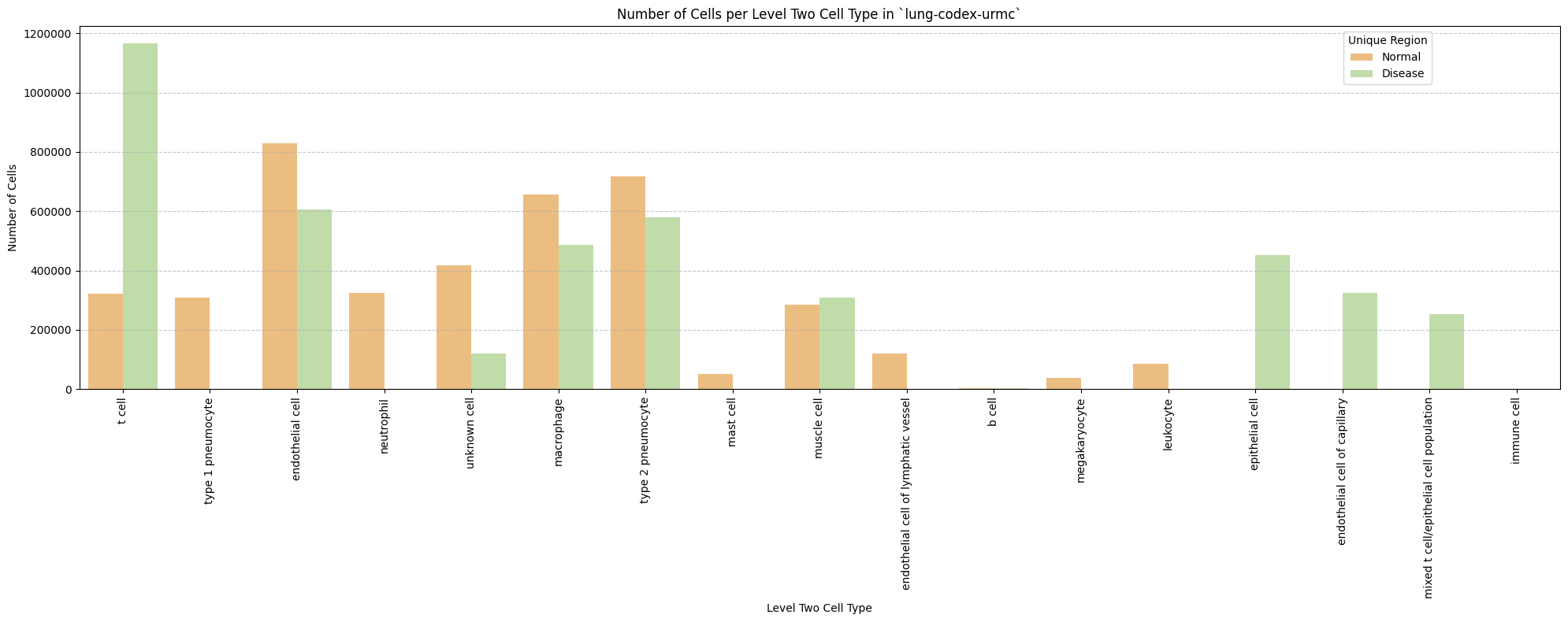

Distance Analysis
# Get mean, median, minimum, maximum distance per unique region per anchor cell type.
df_distance_stats = df_all_edges_with_cell_types.groupby(['Unique Region', 'Anchor Cell Type', 'Anchor Cell Type Level']).agg(
mean_distance=('Distance', 'mean'),
median_distance=('Distance', 'median'),
min_distance=('Distance', 'min'),
max_distance=('Distance', 'max')
).reset_index()
# Print the first few rows of the distance statistics DataFrame.
df_distance_stats| Unique Region | Anchor Cell Type | Anchor Cell Type Level | mean_distance | median_distance | min_distance | max_distance | |
|---|---|---|---|---|---|---|---|
| 0 | Disease | endothelial cell | Level One Cell Type | 42.723724 | 30.471857 | 4.826959 | 199.996537 |
| 1 | Disease | endothelial cell | Level Three Cell Type | 46.507558 | 34.814730 | 4.317932 | 199.976085 |
| 2 | Disease | endothelial cell | Level Two Cell Type | 46.507558 | 34.814730 | 4.317932 | 199.976085 |
| 3 | Disease | endothelial cell of capillary | Level Three Cell Type | 62.225686 | 49.163320 | 4.317932 | 199.998891 |
| 4 | Disease | endothelial cell of capillary | Level Two Cell Type | 62.225686 | 49.163320 | 4.317932 | 199.998891 |
| 5 | Normal | endothelial cell | Level One Cell Type | 38.755288 | 31.499763 | 4.467862 | 199.906751 |
| 6 | Normal | endothelial cell | Level Three Cell Type | 45.655140 | 35.412244 | 4.467862 | 199.967962 |
| 7 | Normal | endothelial cell | Level Two Cell Type | 45.655140 | 35.412244 | 4.467862 | 199.967962 |
| 8 | Normal | endothelial cell of lymphatic vessel | Level Three Cell Type | 100.380353 | 98.949395 | 5.158630 | 199.998081 |
| 9 | Normal | endothelial cell of lymphatic vessel | Level Two Cell Type | 100.380353 | 98.949395 | 5.158630 | 199.998081 |
Level One Cell Type Analysis
# Get mean, median, minimum, maximum distance per cell type in all unique regions.
cell_type_level = 'Level One Cell Type'
df_all_edges_with_cell_type_level = df_all_edges_with_cell_types[(df_all_edges_with_cell_types['Anchor Cell Type Level'] == cell_type_level) & (df_all_edges_with_cell_types['Anchor Cell Type'] == anchor_cell_type_dict[cell_type_level])]
df_distance_stats_cell_type_level = df_all_edges_with_cell_type_level.groupby([cell_type_level, 'Unique Region']).agg(
mean_distance=('Distance', 'mean'),
median_distance=('Distance', 'median'),
min_distance=('Distance', 'min'),
max_distance=('Distance', 'max')
).reset_index()
df_distance_stats_cell_type_level| Level One Cell Type | Unique Region | mean_distance | median_distance | min_distance | max_distance | |
|---|---|---|---|---|---|---|
| 0 | epithelial cell | Disease | 32.455094 | 25.588249 | 4.826959 | 199.648377 |
| 1 | epithelial cell | Normal | 35.403572 | 28.856798 | 4.647661 | 199.778494 |
| 2 | hematopoietic precursor cell | Normal | 34.836844 | 27.595297 | 6.647334 | 183.441998 |
| 3 | immune cell | Disease | 52.244046 | 38.866237 | 5.341610 | 199.996537 |
| 4 | immune cell | Normal | 39.351442 | 31.840836 | 5.332036 | 199.829270 |
| 5 | mesenchymal cell | Disease | 46.334527 | 33.301188 | 5.314126 | 199.976085 |
| 6 | mesenchymal cell | Normal | 49.582849 | 43.837154 | 6.818182 | 199.215219 |
| 7 | mixed immune/epithelial cell population | Disease | 29.528454 | 23.648768 | 6.334930 | 199.968661 |
| 8 | unknown cell | Disease | 21.070750 | 15.768757 | 5.697526 | 190.229178 |
| 9 | unknown cell | Normal | 37.909030 | 30.412302 | 4.467862 | 199.906751 |
# Get top five and bottom five cell types with respect to mean distance in each unique region separately.
def get_top_bottom_cell_types_by_mean(df, cell_type_level, unique_region, top_n=5):
# Filter the DataFrame for the specified unique region and cell type level
df_filtered = df[df['Unique Region'] == unique_region]
# Group by the specified cell type level and calculate mean distance
df_grouped = df_filtered.groupby(cell_type_level).agg(mean_distance=('Distance', 'mean')).reset_index()
# Sort by mean distance to get top and bottom cell types
df_sorted = df_grouped.sort_values(by='mean_distance', ascending=False)
# Get top N and bottom N cell types
top_cell_types = df_sorted.head(top_n)
bottom_cell_types = df_sorted.tail(top_n)
return top_cell_types, bottom_cell_types
# Get top and bottom cell types for each unique region in the dataset.
unique_regions = df_all_edges_with_cell_type_level['Unique Region'].unique()
for region in unique_regions:
top_bottom = get_top_bottom_cell_types_by_mean(df_all_edges_with_cell_type_level, cell_type_level, region)
print(f"\nTop 5 cell types in {region}:")
print(top_bottom[0])
print(f"\nBottom 5 cell types in {region}:")
print(top_bottom[1])
Top 5 cell types in Normal:
Level One Cell Type mean_distance
3 mesenchymal cell 49.582849
2 immune cell 39.351442
4 unknown cell 37.909030
0 epithelial cell 35.403572
1 hematopoietic precursor cell 34.836844
Bottom 5 cell types in Normal:
Level One Cell Type mean_distance
3 mesenchymal cell 49.582849
2 immune cell 39.351442
4 unknown cell 37.909030
0 epithelial cell 35.403572
1 hematopoietic precursor cell 34.836844
Top 5 cell types in Disease:
Level One Cell Type mean_distance
1 immune cell 52.244046
2 mesenchymal cell 46.334527
0 epithelial cell 32.455094
3 mixed immune/epithelial cell population 29.528454
4 unknown cell 21.070750
Bottom 5 cell types in Disease:
Level One Cell Type mean_distance
1 immune cell 52.244046
2 mesenchymal cell 46.334527
0 epithelial cell 32.455094
3 mixed immune/epithelial cell population 29.528454
4 unknown cell 21.070750# Get top five and bottom five cell types with respect to median distance in each unique region separately.
def get_top_bottom_cell_types_by_median(df, cell_type_level, unique_region, top_n=5):
# Filter the DataFrame for the specified unique region and cell type level
df_filtered = df[df['Unique Region'] == unique_region]
# Group by the specified cell type level and calculate median distance
df_grouped = df_filtered.groupby(cell_type_level).agg(median_distance=('Distance', 'median')).reset_index()
# Sort by median distance to get top and bottom cell types
df_sorted = df_grouped.sort_values(by='median_distance', ascending=False)
# Get top N and bottom N cell types
top_cell_types = df_sorted.head(top_n)
bottom_cell_types = df_sorted.tail(top_n)
return top_cell_types, bottom_cell_types
# Get top and bottom cell types for each unique region in the dataset.
unique_regions = df_all_edges_with_cell_type_level['Unique Region'].unique()
for region in unique_regions:
top_bottom = get_top_bottom_cell_types_by_median(df_all_edges_with_cell_type_level, cell_type_level, region)
print(f"\nTop 5 cell types in {region}:")
print(top_bottom[0])
print(f"\nBottom 5 cell types in {region}:")
print(top_bottom[1])
Top 5 cell types in Normal:
Level One Cell Type median_distance
3 mesenchymal cell 43.837154
2 immune cell 31.840836
4 unknown cell 30.412302
0 epithelial cell 28.856798
1 hematopoietic precursor cell 27.595297
Bottom 5 cell types in Normal:
Level One Cell Type median_distance
3 mesenchymal cell 43.837154
2 immune cell 31.840836
4 unknown cell 30.412302
0 epithelial cell 28.856798
1 hematopoietic precursor cell 27.595297
Top 5 cell types in Disease:
Level One Cell Type median_distance
1 immune cell 38.866237
2 mesenchymal cell 33.301188
0 epithelial cell 25.588249
3 mixed immune/epithelial cell population 23.648768
4 unknown cell 15.768757
Bottom 5 cell types in Disease:
Level One Cell Type median_distance
1 immune cell 38.866237
2 mesenchymal cell 33.301188
0 epithelial cell 25.588249
3 mixed immune/epithelial cell population 23.648768
4 unknown cell 15.768757# Calculate regional variability
def calculate_regional_variability(df_all_edges_with_cell_type_level, cell_type_level):
""" Calculate regional variability for distances in the given DataFrame.
"""
regional_variability = df_all_edges_with_cell_type_level.groupby('Unique Region')['Distance'].agg([
('mean', 'mean'),
('std', 'std')
]).round(2)
# Add CV as percentage
regional_variability['CV (%)'] = (regional_variability['std'] / regional_variability['mean'] * 100).round(1)
print("\nRegional Variability Analysis:")
print("Mean: Average distance in each region")
print("Std: Standard deviation of distances")
print("CV: Coefficient of Variation (std/mean * 100%)")
print(regional_variability)
# Calculate variability for each cell type
cell_type_variability = df_all_edges_with_cell_type_level.groupby(cell_type_level)['Distance'].agg([
('mean', 'mean'),
('std', 'std')
]).round(2)
# Add CV as percentage
cell_type_variability['CV (%)'] = (cell_type_variability['std'] / cell_type_variability['mean'] * 100).round(1)
print("\nCell Type Variability Analysis (sorted by CV):")
print(cell_type_variability.sort_values('CV (%)', ascending=False))
calculate_regional_variability(df_all_edges_with_cell_type_level, cell_type_level)
Regional Variability Analysis:
Mean: Average distance in each region
Std: Standard deviation of distances
CV: Coefficient of Variation (std/mean * 100%)
mean std CV (%)
Unique Region
Disease 42.72 34.40 80.5
Normal 38.76 26.44 68.2
Cell Type Variability Analysis (sorted by CV):
mean std CV (%)
Level One Cell Type
unknown cell 34.17 25.86 75.7
immune cell 46.17 34.71 75.2
mesenchymal cell 47.92 33.60 70.1
hematopoietic precursor cell 34.84 24.25 69.6
epithelial cell 33.93 23.11 68.1
mixed immune/epithelial cell population 29.53 19.66 66.6# Generate Violin Plot
def plot_violin_cells_per_celltype(df_all_edges_with_cell_type_level, cell_type_level, output_dir, density_norm='area'):
sns.set_style("whitegrid")
sns.set_context("notebook", rc={"grid.linewidth": 2})
plt.figure(figsize=(10, 6))
plt.rcParams["svg.fonttype"] = 'none' # to store text as text, not as path
sns.violinplot(data=df_all_edges_with_cell_type_level, x=cell_type_level, y="Distance", density_norm=density_norm, common_norm=True, cut=0, inner="box", split=False, palette='Spectral', alpha=.9)
sns.set_theme(style="whitegrid")
sns.set_context("paper")
font_size = 10
plt.legend(fontsize=font_size)
plt.title(f'Violin Plot of distances by {cell_type_level} (Density Normalization: {density_norm})', fontsize=font_size)
plt.xlabel(f'{cell_type_level}', fontsize=font_size)
plt.ylabel('Distance (\u03bcm)', fontsize=font_size)
# Increase font size for all text in the figure
plt.xticks(fontsize=font_size)
plt.xticks(rotation=90)
plt.yticks(fontsize=font_size)
plt.tight_layout()
plt.savefig(os.path.join(output_dir, f'{dataset_dir}_violin_cells_per_celltype_{cell_type_level}.png'), dpi=300,
bbox_inches='tight',
pad_inches=0.5)
plt.savefig(os.path.join(output_dir, f'{dataset_dir}_violin_cells_per_celltype_{cell_type_level}.svg'), dpi=300,
bbox_inches='tight',
pad_inches=0.5)
plt.show()
plot_violin_cells_per_celltype(df_all_edges_with_cell_type_level, cell_type_level, os.path.join(basepath, figures_output_dir), density_norm='area')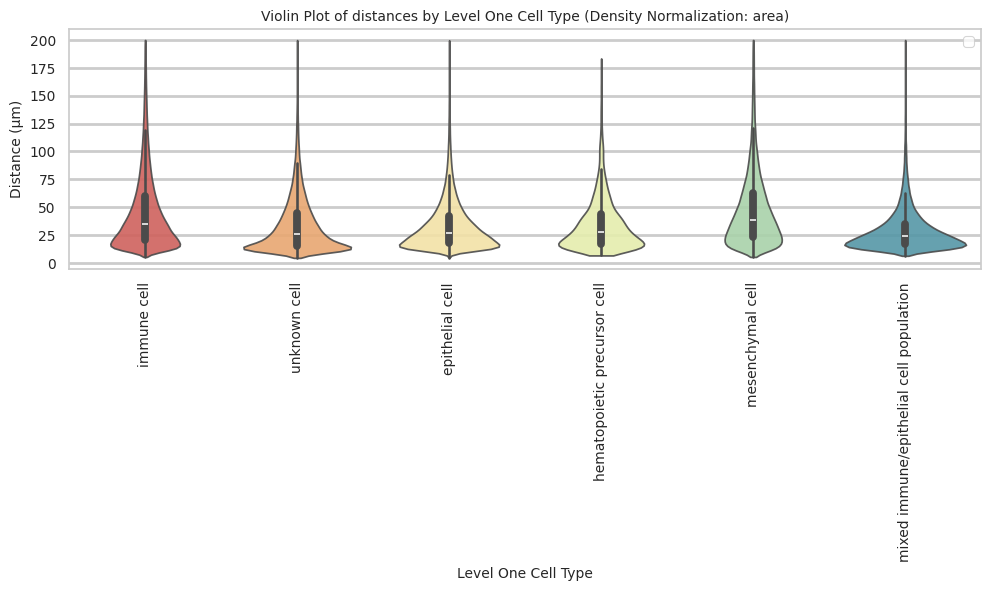
# Boxplots of distribution of distances by cell type and region.
def plot_distance_distribution_boxplots_by_region(df_all_edges_with_cell_type_level, cell_type_level, output_dir):
plt.figure(figsize=(16, 8))
plt.rcParams["svg.fonttype"] = 'none' # to store text as text, not as path
# Create categorical type with only the regions that exist in the data
available_regions = [r for r in regions if r in df_all_edges_with_cell_type_level['Unique Region'].unique()]
df_all_edges_with_cell_type_level['Unique Region'] = pd.Categorical(
df_all_edges_with_cell_type_level['Unique Region'],
categories=available_regions,
ordered=True
)
# Make box plot.
sns.boxplot(data=df_all_edges_with_cell_type_level, x=cell_type_level, y='Distance', hue='Unique Region', showfliers=False, palette='Spectral') # viridis or Spectral palette for better color distinction
font_size = 10
plt.xticks(rotation=90, ha='right', fontsize=font_size)
plt.yticks(fontsize=font_size)
plt.title(f'Distribution of distances by {cell_type_level} and region', fontsize=font_size)
plt.xlabel(f'{cell_type_level}', fontsize=font_size)
plt.ylabel('Distance (\u03bcm)', fontsize=font_size)
plt.legend(bbox_to_anchor=(1, 1), loc='upper left')
plt.tight_layout()
plt.savefig(os.path.join(output_dir, f'{dataset_dir}_distance_distribution_boxplots_by_region_{cell_type_level}.png'), dpi=300,
bbox_inches='tight',
pad_inches=0.5)
plt.savefig(os.path.join(output_dir, f'{dataset_dir}_distance_distribution_boxplots_by_region_{cell_type_level}.svg'), dpi=300,
bbox_inches='tight',
pad_inches=0.5)
plt.show()
plot_distance_distribution_boxplots_by_region(df_all_edges_with_cell_type_level, cell_type_level, os.path.join(basepath, figures_output_dir))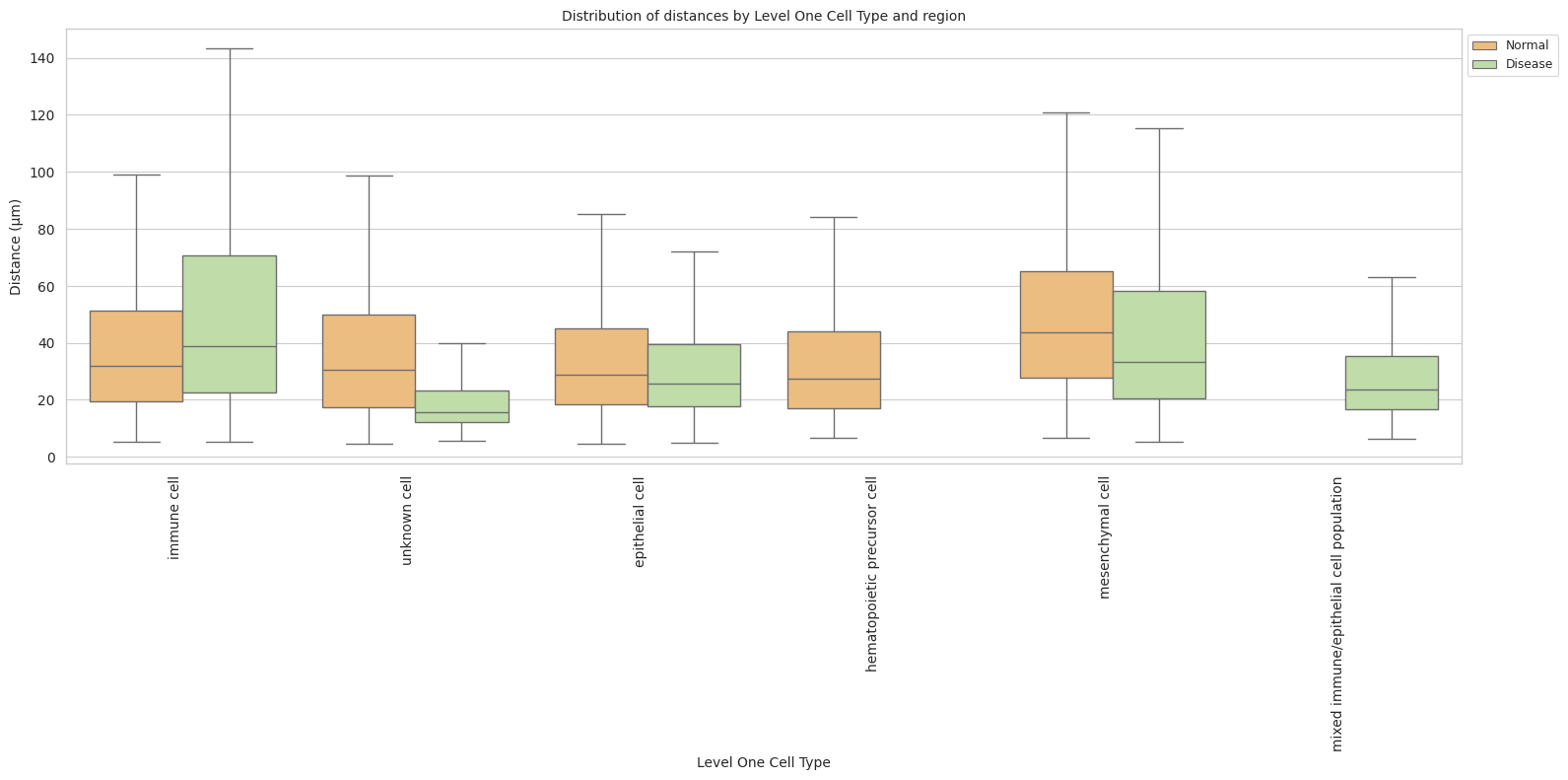
# Boxplots of distribution of distances by cell type and region.
def plot_distance_distribution_heatmap(df_all_edges_with_cell_type_level, cell_type_level, output_dir):
pivot_data = df_all_edges_with_cell_type_level.pivot_table(
values='Distance',
index=cell_type_level,
columns='Unique Region',
aggfunc='median'
)
plt.figure(figsize=(15, 10))
plt.rcParams["svg.fonttype"] = 'none' # to store text as text, not as path
sns.heatmap(pivot_data, annot=True, fmt='.1f', cmap='Spectral')
plt.title(f'Heatmap of median distances by {cell_type_level}', fontsize=12)
font_size = 10
plt.xticks(rotation=90, ha='right', fontsize=font_size)
plt.yticks(fontsize=font_size)
plt.xlabel('Unique Region', fontsize=font_size)
plt.ylabel(f'{cell_type_level}', fontsize=font_size)
plt.tight_layout()
plt.savefig(os.path.join(output_dir, f'{dataset_dir}_distance_distribution_heatmap_{cell_type_level}.png'), dpi=300,
bbox_inches='tight',
pad_inches=0.5)
plt.savefig(os.path.join(output_dir, f'{dataset_dir}_distance_distribution_heatmap_{cell_type_level}.svg'), dpi=300,
bbox_inches='tight',
pad_inches=0.5)
plt.show()
plot_distance_distribution_heatmap(df_all_edges_with_cell_type_level, cell_type_level, os.path.join(basepath, figures_output_dir))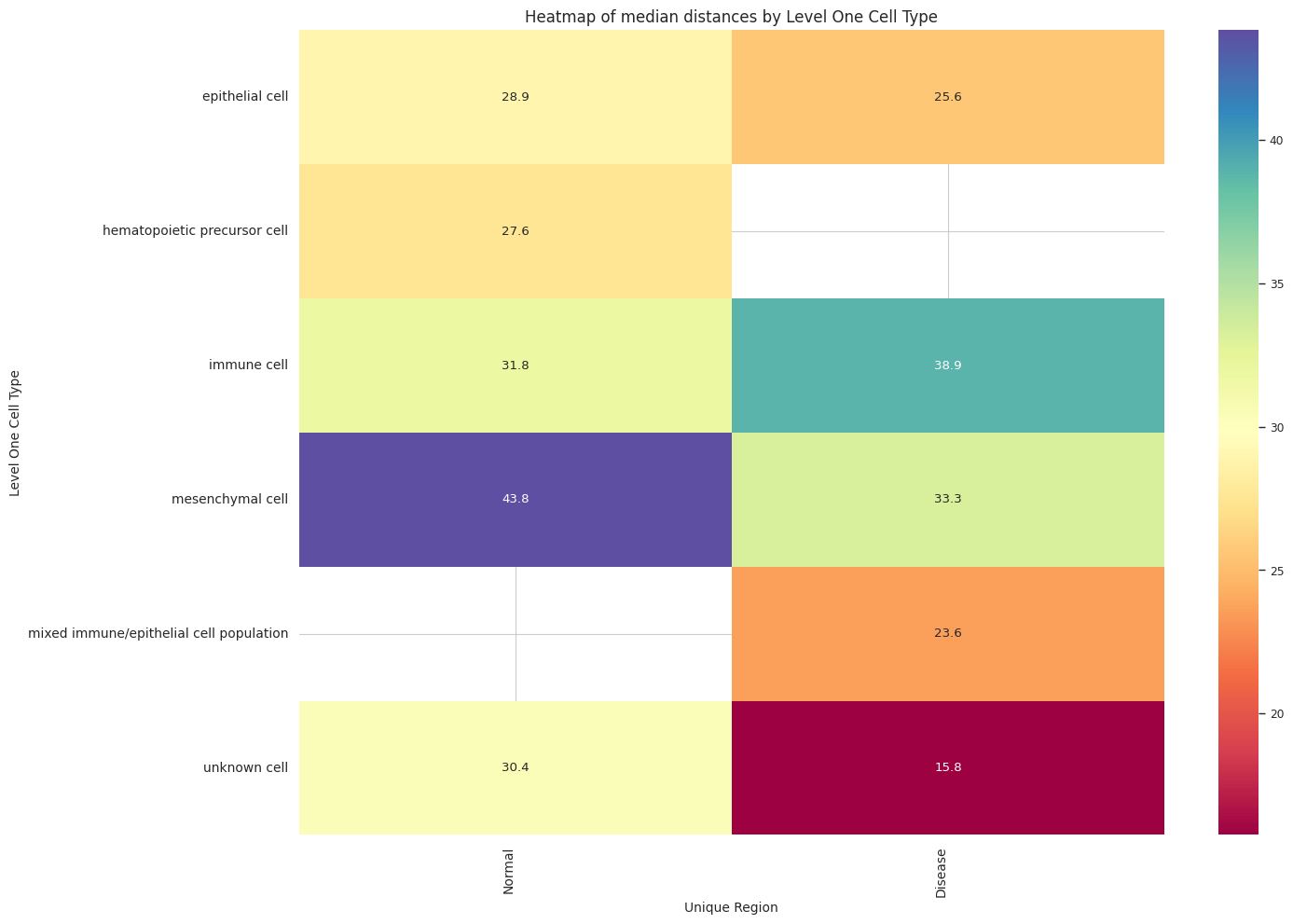
# Generate Violin Plot per unique region in both small intestine and large intestine. Create for all 8 regions as 8 subplots.
def plot_violin_plots_all_regions(df_all_edges_with_cell_type_level, cell_type_level, output_dir, density_norm="area"):
sns.set_style("whitegrid")
sns.set_context("notebook", rc={"grid.linewidth": 1})
plt.rcParams["svg.fonttype"] = 'none' # to store text as text, not as path
font_size = 10
fig, axs = plt.subplots(2, 1, figsize=(10, 15)) # Adjusted figsize for horizontal layout
fig.suptitle(f'Distance distribution per {cell_type_level} in `{dataset_dir}` (density normalization = {density_norm})', fontsize=font_size, y=1)
# Keep the sequence of Cell Types consistent across plots.
cell_types = sorted(df_all_edges_with_cell_type_level[cell_type_level].unique())
# Create a color palette based on the number of unique classes
color_palette = sns.color_palette("Spectral", n_colors=len(cell_types))
# Create a dictionary mapping class to color
class_color_dict = dict(zip(cell_types, color_palette))
for i, region in enumerate(regions):
data_reg = df_all_edges_with_cell_type_level[df_all_edges_with_cell_type_level['Unique Region'] == region]
sns.violinplot(data=data_reg, x=cell_type_level, y="Distance", density_norm=density_norm, common_norm=True, cut=0, inner="box", split=False, palette=class_color_dict, alpha=.9, ax=axs[i], hue=cell_type_level, legend=False, order=cell_types, fill=True)
axs[i].set_title(region, fontsize=font_size)
axs[i].set_xlabel('', fontsize=font_size)
axs[i].set_ylabel('Distance (\u03bcm)', fontsize=font_size)
# axs[i].tick_params(axis='x', labelrotation=90, labelsize=font_size)
# only show xtick labels for the last subplot
if i < len(regions) - 1:
axs[i].set_xticklabels([])
else:
axs[i].set_xticklabels(cell_types, fontsize=font_size, rotation=90, ha='right')
# axs[i].set_ylim(0, data_reg['Distance'].max() * 1.1) # Set y-limits to be consistent across all plots
axs[i].tick_params(axis='both', labelsize=font_size)
# Use fig.text for precise label positioning
fig.figure.text(0.5, -0.02, f'{cell_type_level}', ha='center', va='bottom', fontsize=font_size)
plt.tight_layout()
plt.savefig(os.path.join(output_dir, f'{dataset_dir}_violin_plots_all_regions_{cell_type_level}.png'), dpi=300,
bbox_inches='tight',
pad_inches=0.5)
plt.savefig(os.path.join(output_dir, f'{dataset_dir}_violin_plots_all_regions_{cell_type_level}.svg'), dpi=300,
bbox_inches='tight',
pad_inches=0.5)
plt.show()
plot_violin_plots_all_regions(df_all_edges_with_cell_type_level, cell_type_level, os.path.join(basepath, figures_output_dir), density_norm="count") # density_norm="count" or "area" can be used based on preference.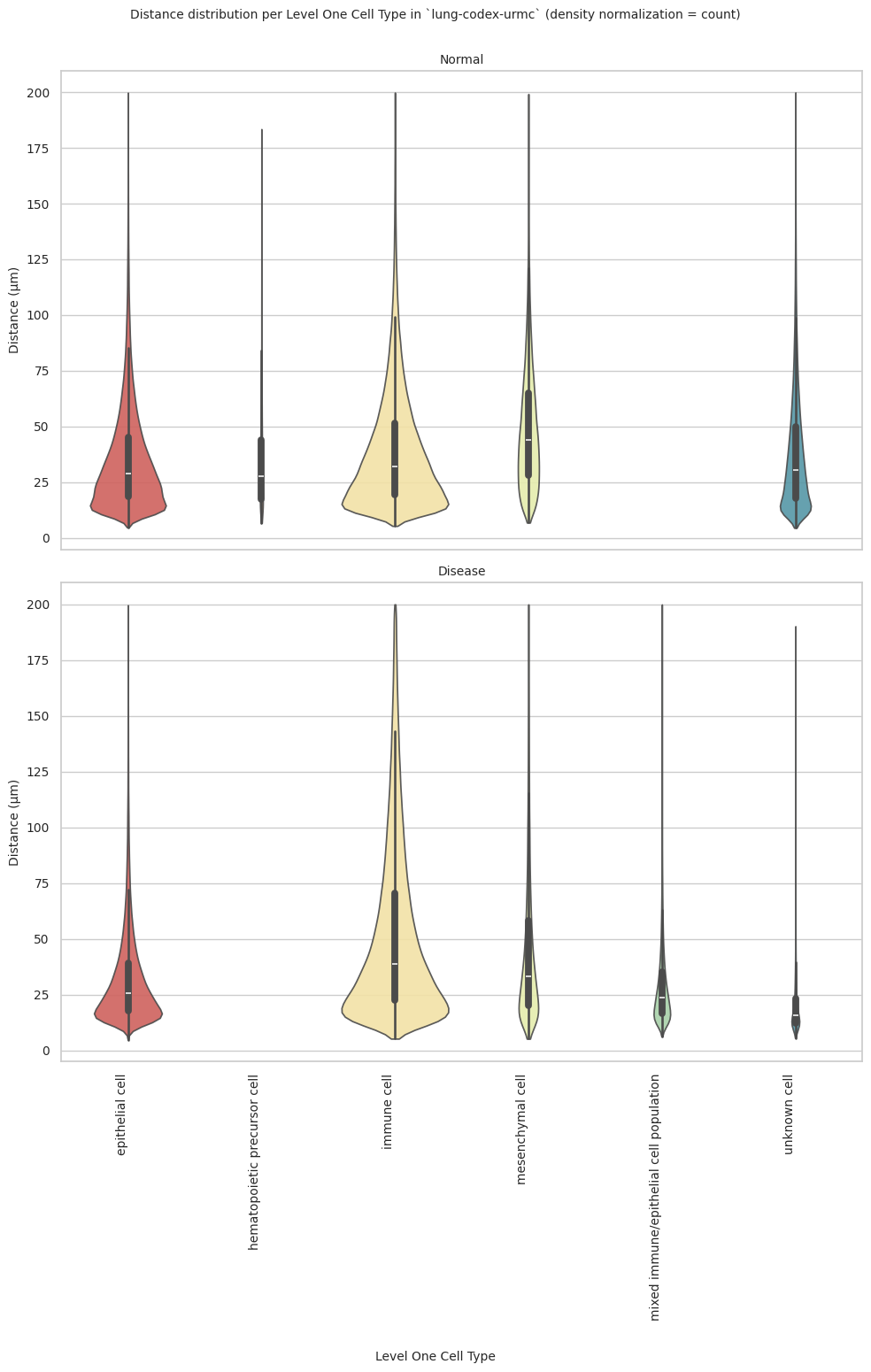
# Generate Split Violin Plot
def plot_violin_cells_per_celltype_split_by_condition(df_all_edges_with_cell_type_level, cell_type_level, output_dir, density_norm="area"):
sns.set_style("whitegrid")
sns.set_context("notebook", rc={"grid.linewidth": 2})
plt.figure(figsize=(15, 10))
plt.rcParams["svg.fonttype"] = 'none' # to store text as text, not as path
sns.violinplot(data=df_all_edges_with_cell_type_level, x=cell_type_level, y="Distance", hue="Unique Region", density_norm=density_norm, common_norm=True, cut=0, inner="box", split=True, palette='Spectral', alpha=.9, hue_order=regions)
sns.set_theme(style="whitegrid")
sns.set_context("paper")
font_size = 10
plt.legend(fontsize=font_size, loc='upper right', bbox_to_anchor=(1.15, 1))
plt.title(f'Split violin plot of distances by {cell_type_level} (Density Normalization: {density_norm})', fontsize=font_size)
plt.xlabel('Cell Type', fontsize=font_size)
plt.ylabel('Distance (\u03bcm)', fontsize=font_size)
# Increase font size for all text in the figure
plt.xticks(fontsize=font_size)
plt.xticks(rotation=90)
plt.yticks(fontsize=font_size)
plt.tight_layout()
plt.savefig(os.path.join(output_dir, f'{dataset_dir}_plot_violin_cells_per_celltype_split_by_condition_{cell_type_level}.png'), dpi=300,
bbox_inches='tight',
pad_inches=0.5)
plt.savefig(os.path.join(output_dir, f'{dataset_dir}_plot_violin_cells_per_celltype_split_by_condition_{cell_type_level}.svg'), dpi=300,
bbox_inches='tight',
pad_inches=0.5)
plt.show()
plot_violin_cells_per_celltype_split_by_condition(df_all_edges_with_cell_type_level, cell_type_level, os.path.join(basepath, figures_output_dir), density_norm="count") # density_norm="count" or "area" can be used based on preference.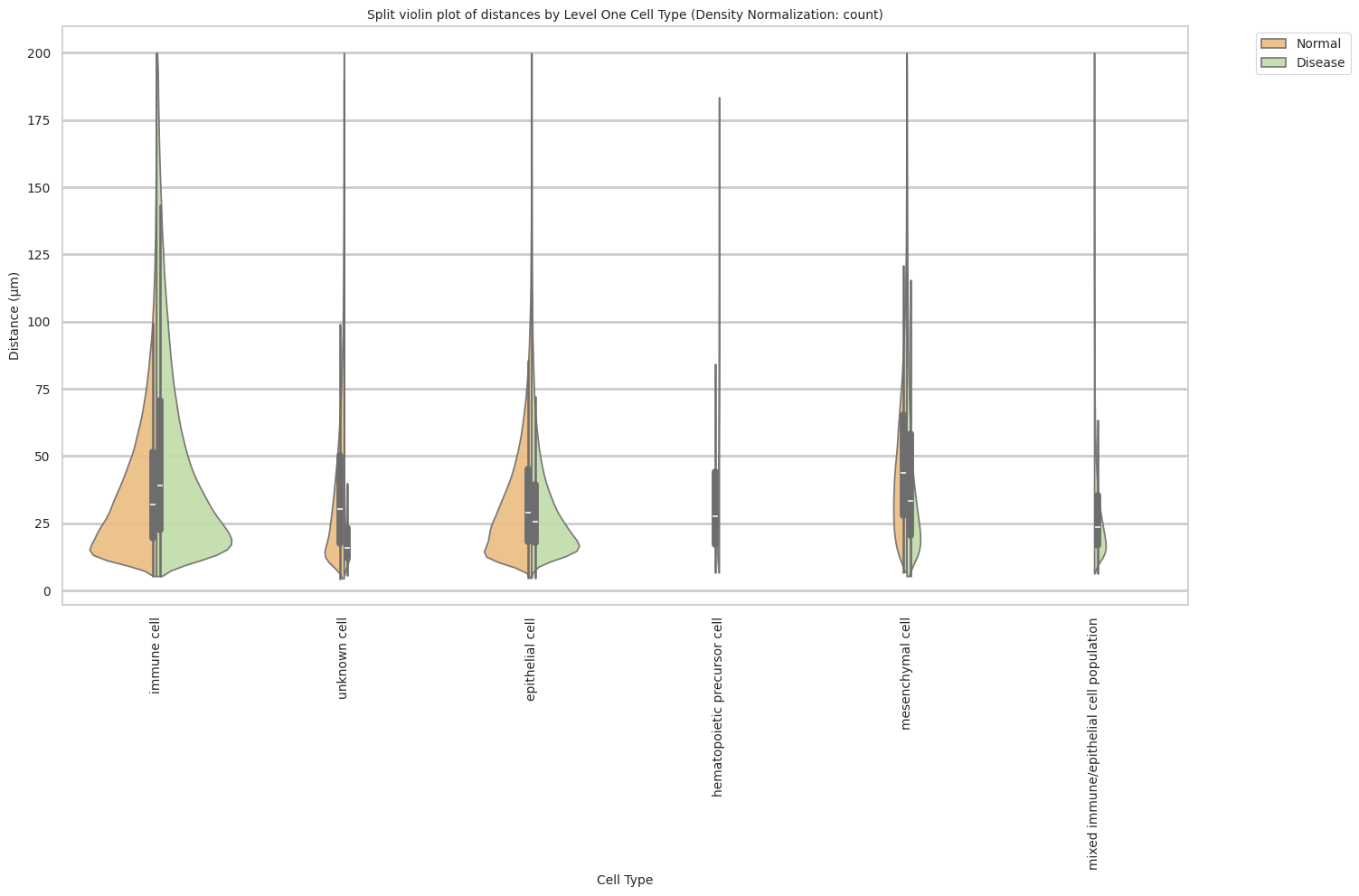
Level Two Cell Type Analysis
# Get mean, median, minimum, maximum distance per cell type in all unique regions.
cell_type_level = 'Level Two Cell Type'
df_all_edges_with_cell_type_level = df_all_edges_with_cell_types[(df_all_edges_with_cell_types['Anchor Cell Type Level'] == cell_type_level) & (df_all_edges_with_cell_types['Anchor Cell Type'] == anchor_cell_type_dict[cell_type_level])]
df_distance_stats_cell_type_level = df_all_edges_with_cell_type_level.groupby([cell_type_level, 'Unique Region']).agg(
mean_distance=('Distance', 'mean'),
median_distance=('Distance', 'median'),
min_distance=('Distance', 'min'),
max_distance=('Distance', 'max')
).reset_index()
df_distance_stats_cell_type_level| Level Two Cell Type | Unique Region | mean_distance | median_distance | min_distance | max_distance | |
|---|---|---|---|---|---|---|
| 0 | b cell | Disease | 37.449808 | 25.025741 | 8.194906 | 191.217795 |
| 1 | b cell | Normal | 36.288294 | 26.858117 | 8.676844 | 197.378220 |
| 2 | endothelial cell of capillary | Disease | 28.936591 | 22.843498 | 4.317932 | 197.145756 |
| 3 | endothelial cell of lymphatic vessel | Normal | 90.450213 | 82.516556 | 6.820439 | 199.965441 |
| 4 | epithelial cell | Disease | 47.290109 | 39.116006 | 7.217011 | 199.626286 |
| 5 | immune cell | Disease | 199.429368 | 199.429368 | 199.429368 | 199.429368 |
| 6 | leukocyte | Normal | 35.224795 | 27.520283 | 6.271830 | 198.055232 |
| 7 | macrophage | Disease | 72.456390 | 62.749724 | 6.409083 | 199.948392 |
| 8 | macrophage | Normal | 43.693437 | 35.902059 | 5.764018 | 199.800005 |
| 9 | mast cell | Normal | 56.037289 | 45.889204 | 6.549645 | 199.829270 |
| 10 | megakaryocyte | Normal | 35.709374 | 28.120303 | 6.647334 | 183.441998 |
| 11 | mixed t cell/epithelial cell population | Disease | 35.456705 | 28.416673 | 7.589362 | 199.630836 |
| 12 | muscle cell | Disease | 50.141764 | 37.800183 | 5.314126 | 199.976085 |
| 13 | muscle cell | Normal | 74.768813 | 67.226262 | 7.202741 | 199.967962 |
| 14 | neutrophil | Normal | 34.791835 | 27.134180 | 5.332036 | 199.638840 |
| 15 | t cell | Disease | 49.913913 | 37.638729 | 5.341610 | 199.924082 |
| 16 | t cell | Normal | 52.112910 | 41.077107 | 5.873783 | 199.929988 |
| 17 | type 1 pneumocyte | Normal | 36.197262 | 26.538157 | 5.164310 | 199.815662 |
| 18 | type 2 pneumocyte | Disease | 35.069124 | 29.533140 | 7.236066 | 199.648377 |
| 19 | type 2 pneumocyte | Normal | 40.193411 | 31.636089 | 4.647661 | 199.955656 |
| 20 | unknown cell | Disease | 27.554498 | 20.212155 | 5.697526 | 196.945710 |
| 21 | unknown cell | Normal | 43.607941 | 34.399009 | 4.467862 | 199.906751 |
# Get top and bottom cell types for each unique region in the dataset.
unique_regions = df_all_edges_with_cell_type_level['Unique Region'].unique()
for region in unique_regions:
top_bottom = get_top_bottom_cell_types_by_mean(df_all_edges_with_cell_type_level, cell_type_level, region)
print(f"\nTop 5 cell types in {region}:")
print(top_bottom[0])
print(f"\nBottom 5 cell types in {region}:")
print(top_bottom[1])
Top 5 cell types in Normal:
Level Two Cell Type mean_distance
1 endothelial cell of lymphatic vessel 90.450213
6 muscle cell 74.768813
4 mast cell 56.037289
8 t cell 52.112910
3 macrophage 43.693437
Bottom 5 cell types in Normal:
Level Two Cell Type mean_distance
0 b cell 36.288294
9 type 1 pneumocyte 36.197262
5 megakaryocyte 35.709374
2 leukocyte 35.224795
7 neutrophil 34.791835
Top 5 cell types in Disease:
Level Two Cell Type mean_distance
3 immune cell 199.429368
4 macrophage 72.456390
6 muscle cell 50.141764
7 t cell 49.913913
2 epithelial cell 47.290109
Bottom 5 cell types in Disease:
Level Two Cell Type mean_distance
0 b cell 37.449808
5 mixed t cell/epithelial cell population 35.456705
8 type 2 pneumocyte 35.069124
1 endothelial cell of capillary 28.936591
9 unknown cell 27.554498# Get top and bottom cell types for each unique region in the dataset.
unique_regions = df_all_edges_with_cell_type_level['Unique Region'].unique()
for region in unique_regions:
top_bottom = get_top_bottom_cell_types_by_median(df_all_edges_with_cell_type_level, cell_type_level, region)
print(f"\nTop 5 cell types in {region}:")
print(top_bottom[0])
print(f"\nBottom 5 cell types in {region}:")
print(top_bottom[1])
Top 5 cell types in Normal:
Level Two Cell Type median_distance
1 endothelial cell of lymphatic vessel 82.516556
6 muscle cell 67.226262
4 mast cell 45.889204
8 t cell 41.077107
3 macrophage 35.902059
Bottom 5 cell types in Normal:
Level Two Cell Type median_distance
5 megakaryocyte 28.120303
2 leukocyte 27.520283
7 neutrophil 27.134180
0 b cell 26.858117
9 type 1 pneumocyte 26.538157
Top 5 cell types in Disease:
Level Two Cell Type median_distance
3 immune cell 199.429368
4 macrophage 62.749724
2 epithelial cell 39.116006
6 muscle cell 37.800183
7 t cell 37.638729
Bottom 5 cell types in Disease:
Level Two Cell Type median_distance
8 type 2 pneumocyte 29.533140
5 mixed t cell/epithelial cell population 28.416673
0 b cell 25.025741
1 endothelial cell of capillary 22.843498
9 unknown cell 20.212155calculate_regional_variability(df_all_edges_with_cell_type_level, cell_type_level)
Regional Variability Analysis:
Mean: Average distance in each region
Std: Standard deviation of distances
CV: Coefficient of Variation (std/mean * 100%)
mean std CV (%)
Unique Region
Disease 46.51 35.32 75.9
Normal 45.66 34.14 74.8
Cell Type Variability Analysis (sorted by CV):
mean std CV (%)
Level Two Cell Type
type 1 pneumocyte 36.20 28.99 80.1
b cell 36.89 29.26 79.3
unknown cell 40.03 30.98 77.4
t cell 50.39 37.60 74.6
neutrophil 34.79 24.90 71.6
leukocyte 35.22 25.04 71.1
megakaryocyte 35.71 25.36 71.0
macrophage 55.66 39.15 70.3
type 2 pneumocyte 37.89 25.70 67.8
mixed t cell/epithelial cell population 35.46 23.98 67.6
endothelial cell of capillary 28.94 19.51 67.4
muscle cell 61.52 41.15 66.9
mast cell 56.04 36.88 65.8
epithelial cell 47.29 30.10 63.6
endothelial cell of lymphatic vessel 90.45 48.80 54.0
immune cell 199.43 NaN NaNplot_violin_cells_per_celltype(df_all_edges_with_cell_type_level, cell_type_level, os.path.join(basepath, figures_output_dir), density_norm='area')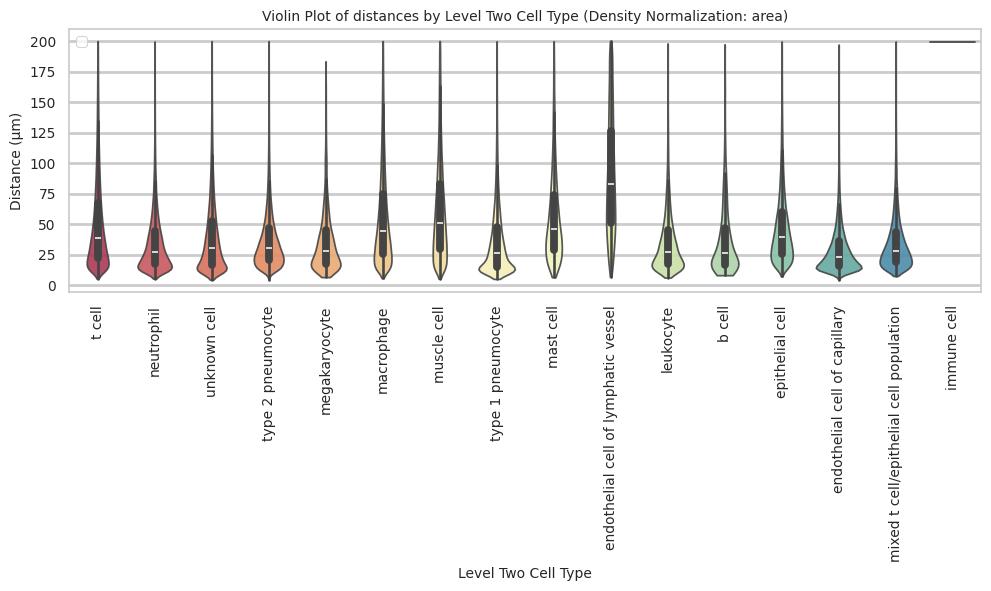
plot_distance_distribution_boxplots_by_region(df_all_edges_with_cell_type_level, cell_type_level, os.path.join(basepath, figures_output_dir))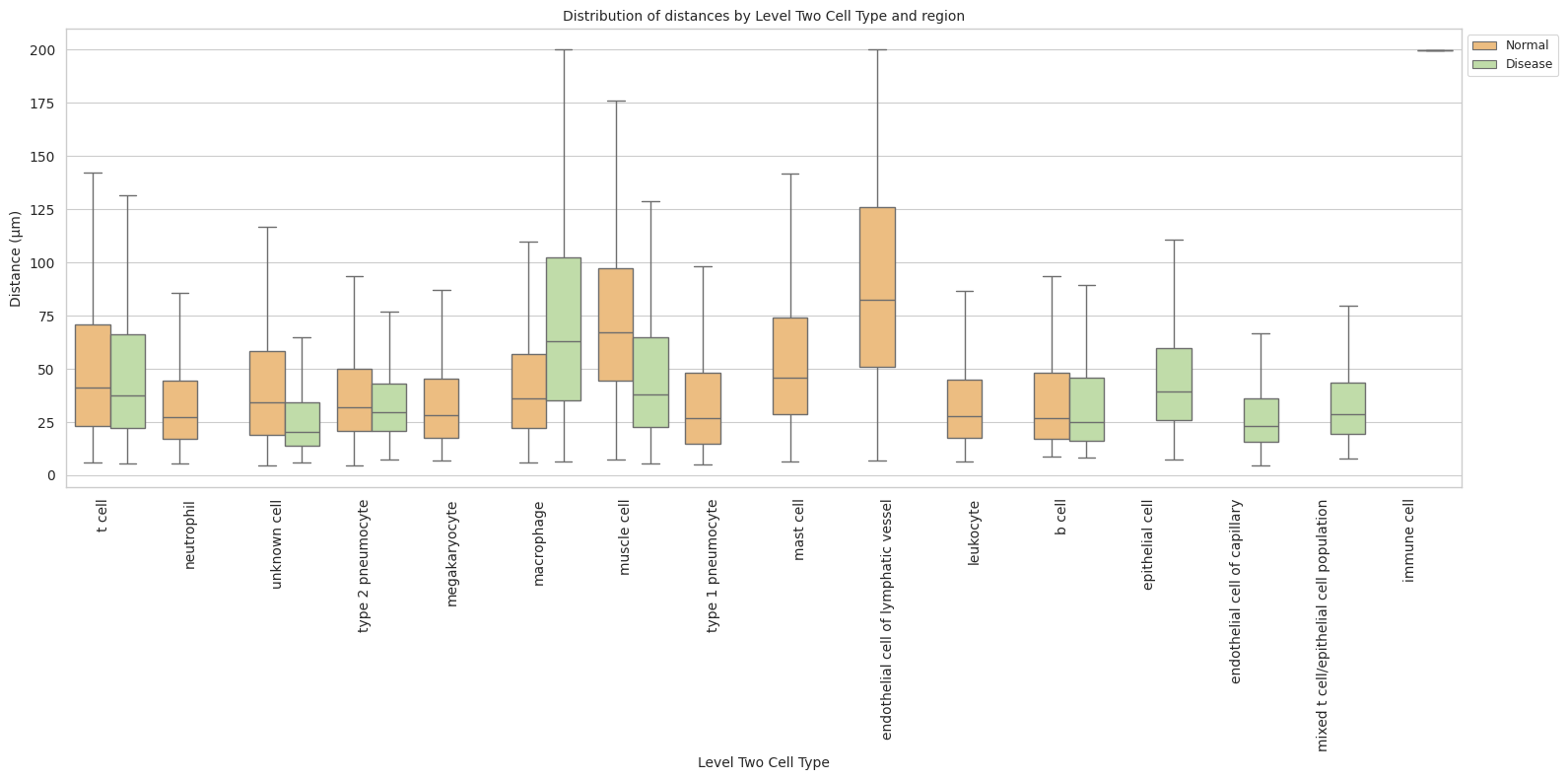
plot_distance_distribution_heatmap(df_all_edges_with_cell_type_level, cell_type_level, os.path.join(basepath, figures_output_dir))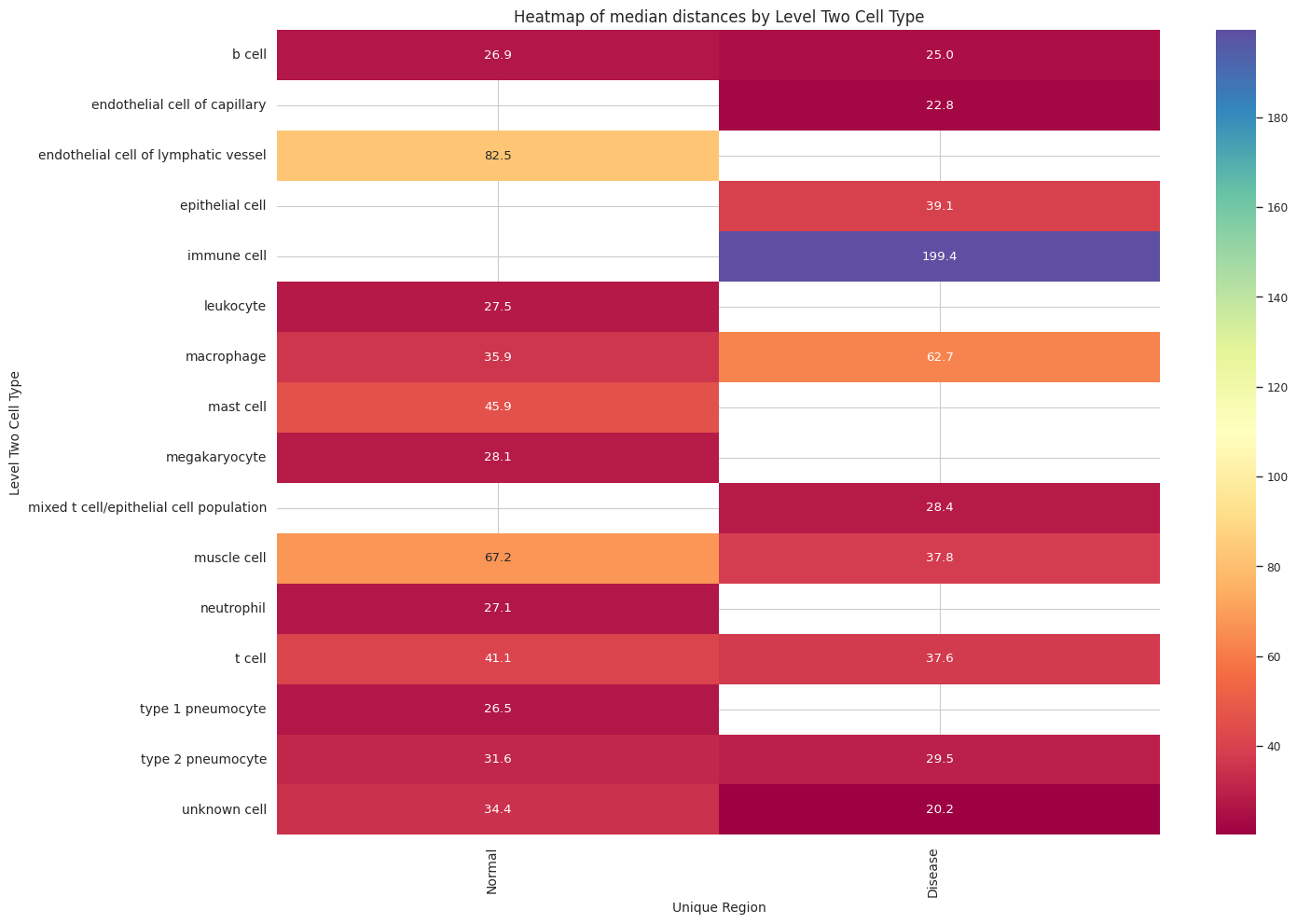
plot_violin_plots_all_regions(df_all_edges_with_cell_type_level, cell_type_level, os.path.join(basepath, figures_output_dir), density_norm="count") # Or, density_norm="count" or "area" based on preference.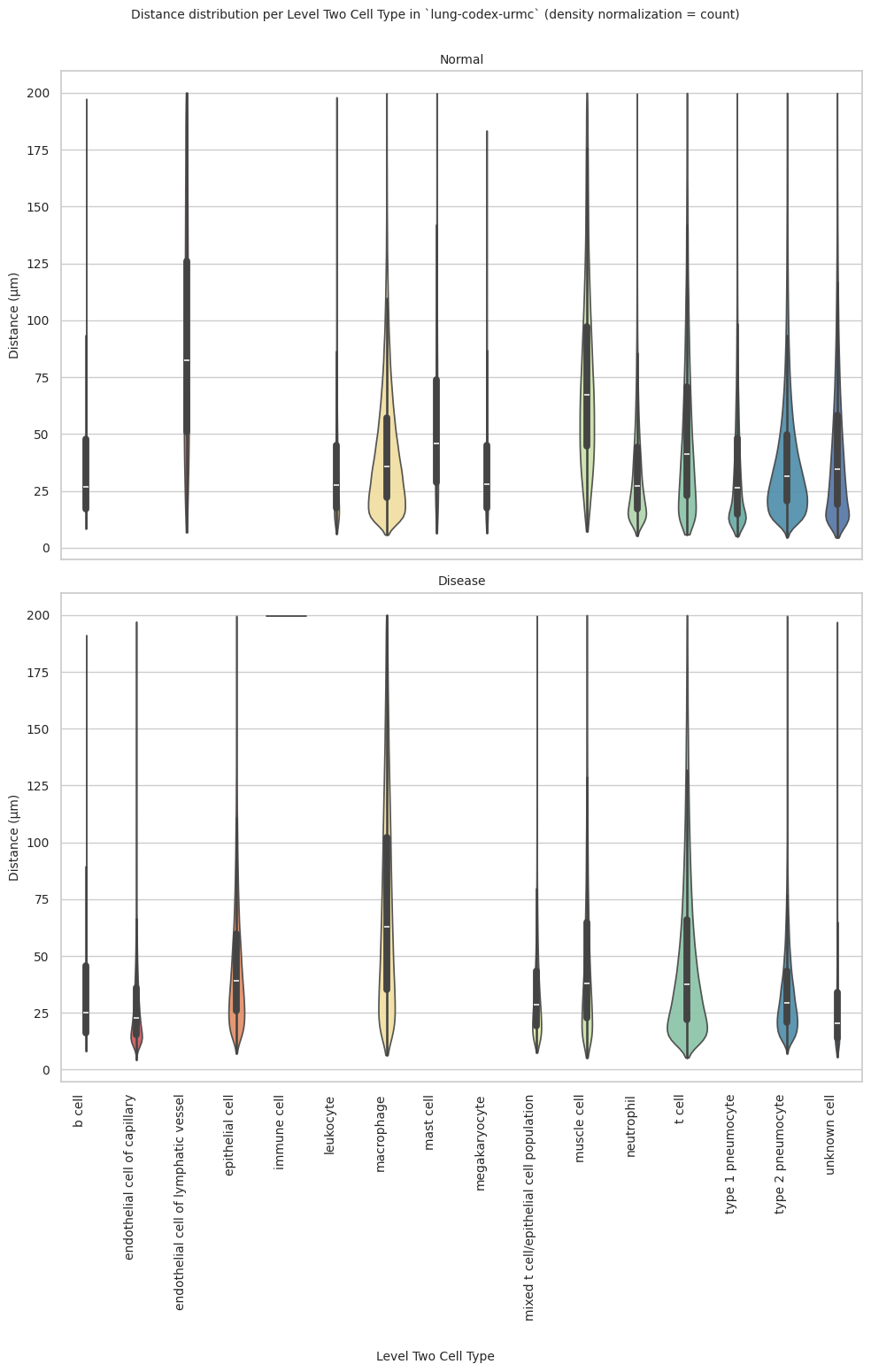
plot_violin_cells_per_celltype_split_by_condition(df_all_edges_with_cell_type_level, cell_type_level, os.path.join(basepath, figures_output_dir), density_norm="count") # density_norm="count" or "area" can be used based on preference.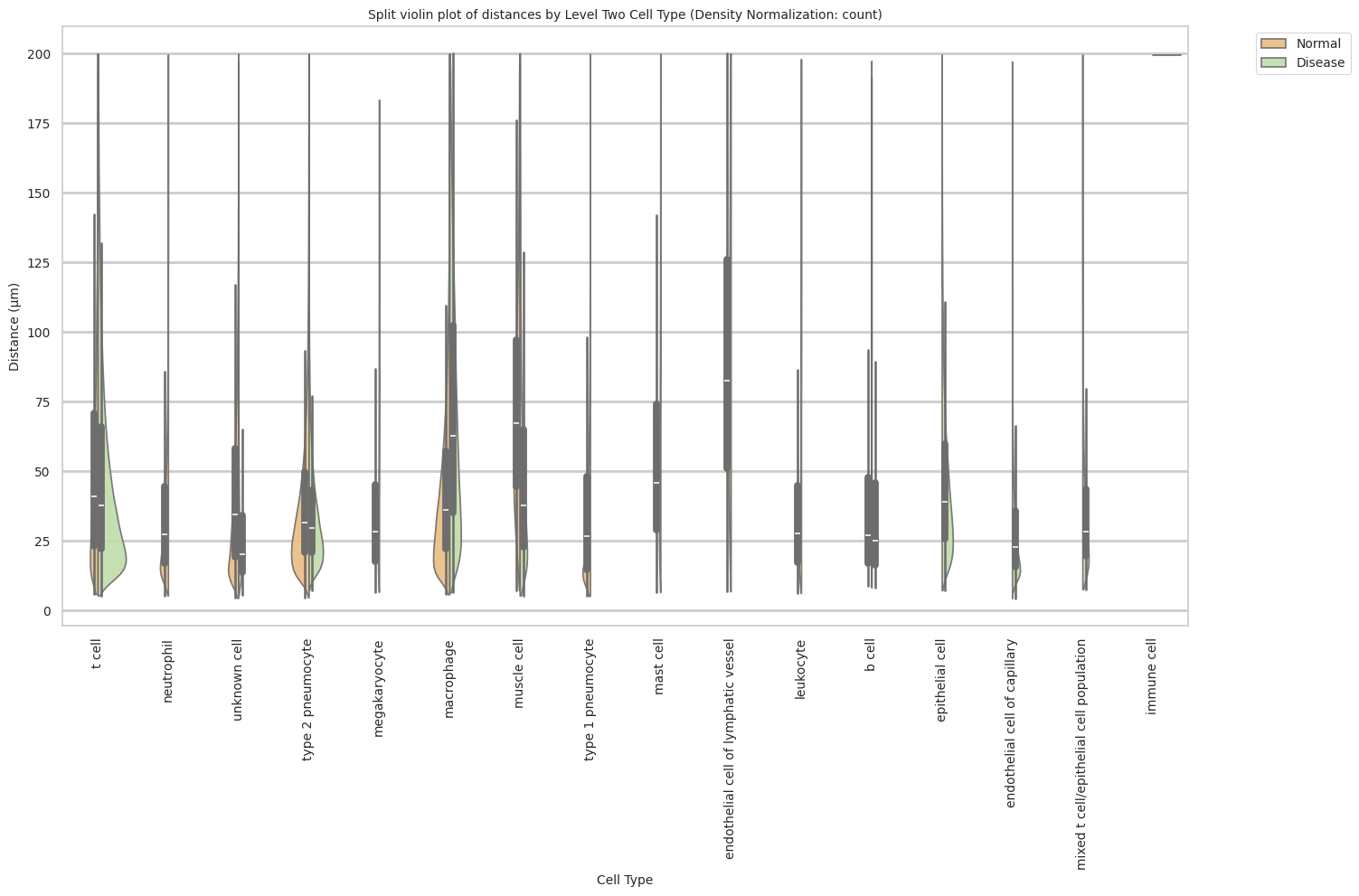
Level Three Cell Type Analysis
# Get mean, median, minimum, maximum distance per cell type in all unique regions.
cell_type_level = 'Level Three Cell Type'
df_all_edges_with_cell_type_level = df_all_edges_with_cell_types[(df_all_edges_with_cell_types['Anchor Cell Type Level'] == cell_type_level) & (df_all_edges_with_cell_types['Anchor Cell Type'] == anchor_cell_type_dict[cell_type_level])]
df_distance_stats_cell_type_level = df_all_edges_with_cell_type_level.groupby([cell_type_level, 'Unique Region']).agg(
mean_distance=('Distance', 'mean'),
median_distance=('Distance', 'median'),
min_distance=('Distance', 'min'),
max_distance=('Distance', 'max')
).reset_index()
df_distance_stats_cell_type_level| Level Three Cell Type | Unique Region | mean_distance | median_distance | min_distance | max_distance | |
|---|---|---|---|---|---|---|
| 0 | b cell | Disease | 37.449808 | 25.025741 | 8.194906 | 191.217795 |
| 1 | b cell | Normal | 36.288294 | 26.858117 | 8.676844 | 197.378220 |
| 2 | endothelial cell of capillary | Disease | 28.936591 | 22.843498 | 4.317932 | 197.145756 |
| 3 | endothelial cell of lymphatic vessel | Normal | 90.450213 | 82.516556 | 6.820439 | 199.965441 |
| 4 | epithelial cell | Disease | 47.290109 | 39.116006 | 7.217011 | 199.626286 |
| 5 | immune cell | Disease | 199.429368 | 199.429368 | 199.429368 | 199.429368 |
| 6 | leukocyte | Normal | 35.224795 | 27.520283 | 6.271830 | 198.055232 |
| 7 | macrophage | Disease | 72.456390 | 62.749724 | 6.409083 | 199.948392 |
| 8 | macrophage | Normal | 43.683982 | 35.893711 | 5.764018 | 199.800005 |
| 9 | macrophage:interstitial | Normal | 47.581049 | 39.836315 | 9.818172 | 172.605327 |
| 10 | mast cell | Normal | 56.037289 | 45.889204 | 6.549645 | 199.829270 |
| 11 | megakaryocyte | Normal | 35.709374 | 28.120303 | 6.647334 | 183.441998 |
| 12 | mixed t cell/epithelial cell population | Disease | 35.456705 | 28.416673 | 7.589362 | 199.630836 |
| 13 | muscle cell:smooth | Disease | 50.141764 | 37.800183 | 5.314126 | 199.976085 |
| 14 | muscle cell:smooth | Normal | 74.768813 | 67.226262 | 7.202741 | 199.967962 |
| 15 | neutrophil | Normal | 34.791835 | 27.134180 | 5.332036 | 199.638840 |
| 16 | pneumocyte:type 1 | Normal | 36.197262 | 26.538157 | 5.164310 | 199.815662 |
| 17 | pneumocyte:type 2 | Disease | 35.069124 | 29.533140 | 7.236066 | 199.648377 |
| 18 | pneumocyte:type 2 | Normal | 40.193411 | 31.636089 | 4.647661 | 199.955656 |
| 19 | t cell | Disease | 52.833976 | 43.817389 | 7.516588 | 199.586367 |
| 20 | t cell:cd4+ alpha-beta | Disease | 39.855009 | 30.664763 | 5.341610 | 199.765323 |
| 21 | t cell:cd4+ alpha-beta | Normal | 61.190621 | 50.726455 | 6.368590 | 199.929988 |
| 22 | t cell:cd8+ | Disease | 72.166680 | 63.643480 | 7.237513 | 199.924082 |
| 23 | t cell:cd8+ | Normal | 45.077855 | 35.291540 | 5.873783 | 199.742345 |
| 24 | unknown cell | Disease | 27.554498 | 20.212155 | 5.697526 | 196.945710 |
| 25 | unknown cell | Normal | 43.607941 | 34.399009 | 4.467862 | 199.906751 |
# Get top and bottom cell types for each unique region in the dataset.
unique_regions = df_all_edges_with_cell_type_level['Unique Region'].unique()
for region in unique_regions:
top_bottom = get_top_bottom_cell_types_by_mean(df_all_edges_with_cell_type_level, cell_type_level, region)
print(f"\nTop 5 cell types in {region}:")
print(top_bottom[0])
print(f"\nBottom 5 cell types in {region}:")
print(top_bottom[1])
Top 5 cell types in Normal:
Level Three Cell Type mean_distance
1 endothelial cell of lymphatic vessel 90.450213
7 muscle cell:smooth 74.768813
11 t cell:cd4+ alpha-beta 61.190621
5 mast cell 56.037289
4 macrophage:interstitial 47.581049
Bottom 5 cell types in Normal:
Level Three Cell Type mean_distance
0 b cell 36.288294
9 pneumocyte:type 1 36.197262
6 megakaryocyte 35.709374
2 leukocyte 35.224795
8 neutrophil 34.791835
Top 5 cell types in Disease:
Level Three Cell Type mean_distance
3 immune cell 199.429368
4 macrophage 72.456390
10 t cell:cd8+ 72.166680
8 t cell 52.833976
6 muscle cell:smooth 50.141764
Bottom 5 cell types in Disease:
Level Three Cell Type mean_distance
0 b cell 37.449808
5 mixed t cell/epithelial cell population 35.456705
7 pneumocyte:type 2 35.069124
1 endothelial cell of capillary 28.936591
11 unknown cell 27.554498# Get top and bottom cell types for each unique region in the dataset.
unique_regions = df_all_edges_with_cell_type_level['Unique Region'].unique()
for region in unique_regions:
top_bottom = get_top_bottom_cell_types_by_median(df_all_edges_with_cell_type_level, cell_type_level, region)
print(f"\nTop 5 cell types in {region}:")
print(top_bottom[0])
print(f"\nBottom 5 cell types in {region}:")
print(top_bottom[1])
Top 5 cell types in Normal:
Level Three Cell Type median_distance
1 endothelial cell of lymphatic vessel 82.516556
7 muscle cell:smooth 67.226262
11 t cell:cd4+ alpha-beta 50.726455
5 mast cell 45.889204
4 macrophage:interstitial 39.836315
Bottom 5 cell types in Normal:
Level Three Cell Type median_distance
6 megakaryocyte 28.120303
2 leukocyte 27.520283
8 neutrophil 27.134180
0 b cell 26.858117
9 pneumocyte:type 1 26.538157
Top 5 cell types in Disease:
Level Three Cell Type median_distance
3 immune cell 199.429368
10 t cell:cd8+ 63.643480
4 macrophage 62.749724
8 t cell 43.817389
2 epithelial cell 39.116006
Bottom 5 cell types in Disease:
Level Three Cell Type median_distance
7 pneumocyte:type 2 29.533140
5 mixed t cell/epithelial cell population 28.416673
0 b cell 25.025741
1 endothelial cell of capillary 22.843498
11 unknown cell 20.212155calculate_regional_variability(df_all_edges_with_cell_type_level, cell_type_level)
Regional Variability Analysis:
Mean: Average distance in each region
Std: Standard deviation of distances
CV: Coefficient of Variation (std/mean * 100%)
mean std CV (%)
Unique Region
Disease 46.51 35.32 75.9
Normal 45.66 34.14 74.8
Cell Type Variability Analysis (sorted by CV):
mean std CV (%)
Level Three Cell Type
pneumocyte:type 1 36.20 28.99 80.1
b cell 36.89 29.26 79.3
unknown cell 40.03 30.98 77.4
t cell:cd4+ alpha-beta 43.13 32.55 75.5
neutrophil 34.79 24.90 71.6
leukocyte 35.22 25.04 71.1
megakaryocyte 35.71 25.36 71.0
macrophage 55.67 39.15 70.3
macrophage:interstitial 47.58 32.59 68.5
t cell:cd8+ 62.80 42.56 67.8
pneumocyte:type 2 37.89 25.70 67.8
mixed t cell/epithelial cell population 35.46 23.98 67.6
endothelial cell of capillary 28.94 19.51 67.4
muscle cell:smooth 61.52 41.15 66.9
mast cell 56.04 36.88 65.8
t cell 52.83 34.08 64.5
epithelial cell 47.29 30.10 63.6
endothelial cell of lymphatic vessel 90.45 48.80 54.0
immune cell 199.43 NaN NaNplot_violin_cells_per_celltype(df_all_edges_with_cell_type_level, cell_type_level, os.path.join(basepath, figures_output_dir), density_norm='area')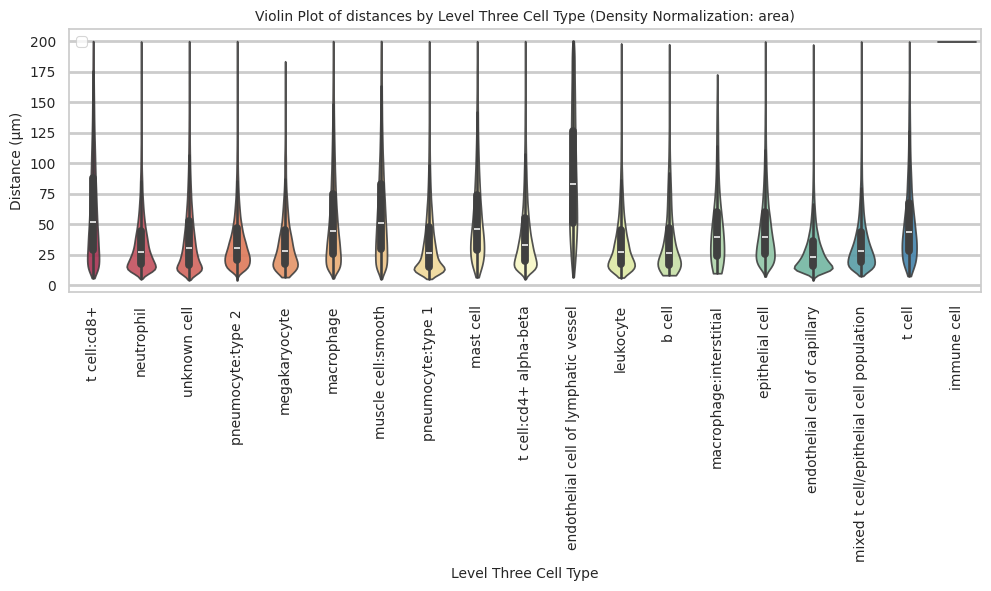
plot_distance_distribution_boxplots_by_region(df_all_edges_with_cell_type_level, cell_type_level, os.path.join(basepath, figures_output_dir))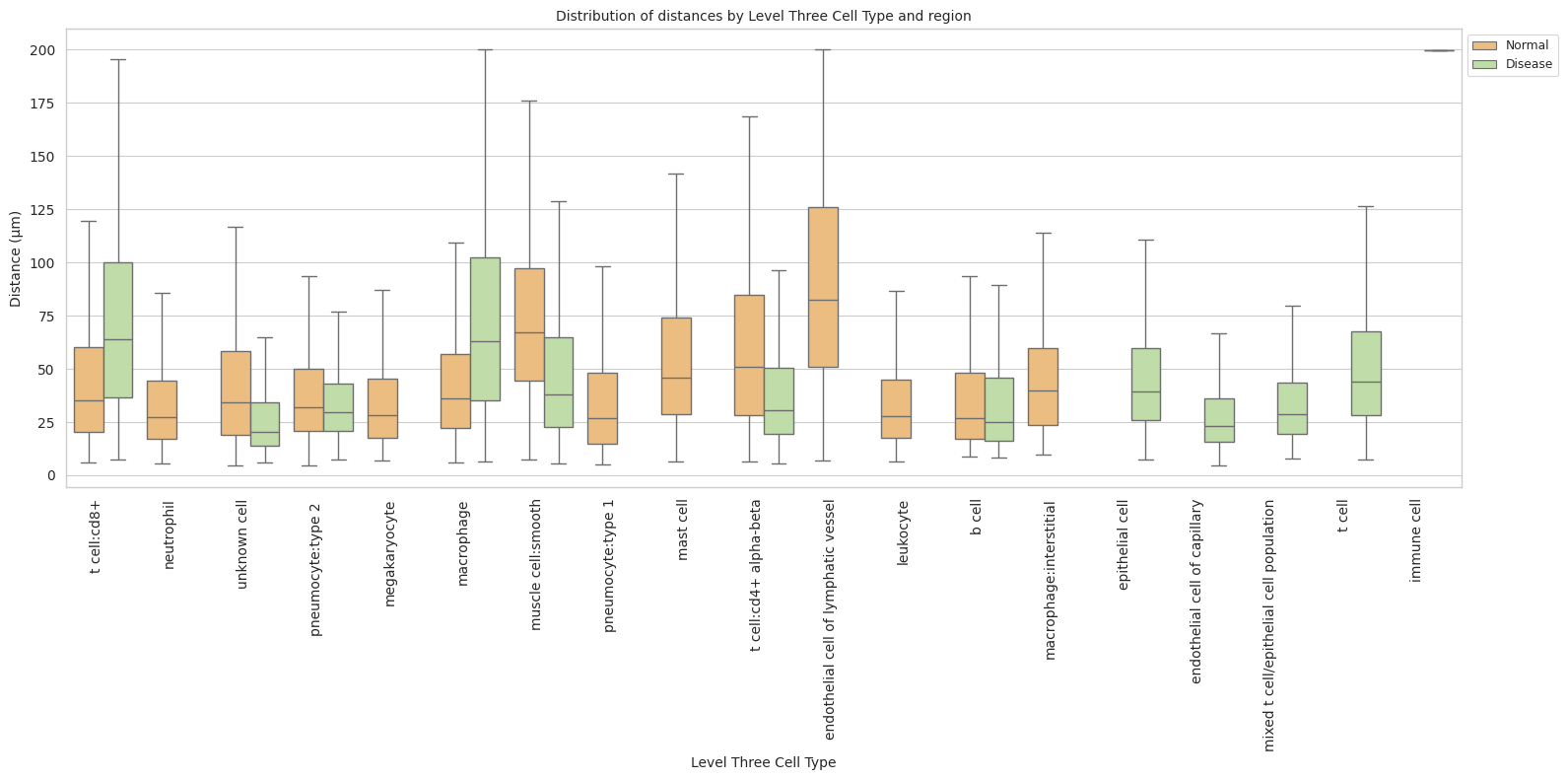
plot_distance_distribution_heatmap(df_all_edges_with_cell_type_level, cell_type_level, os.path.join(basepath, figures_output_dir))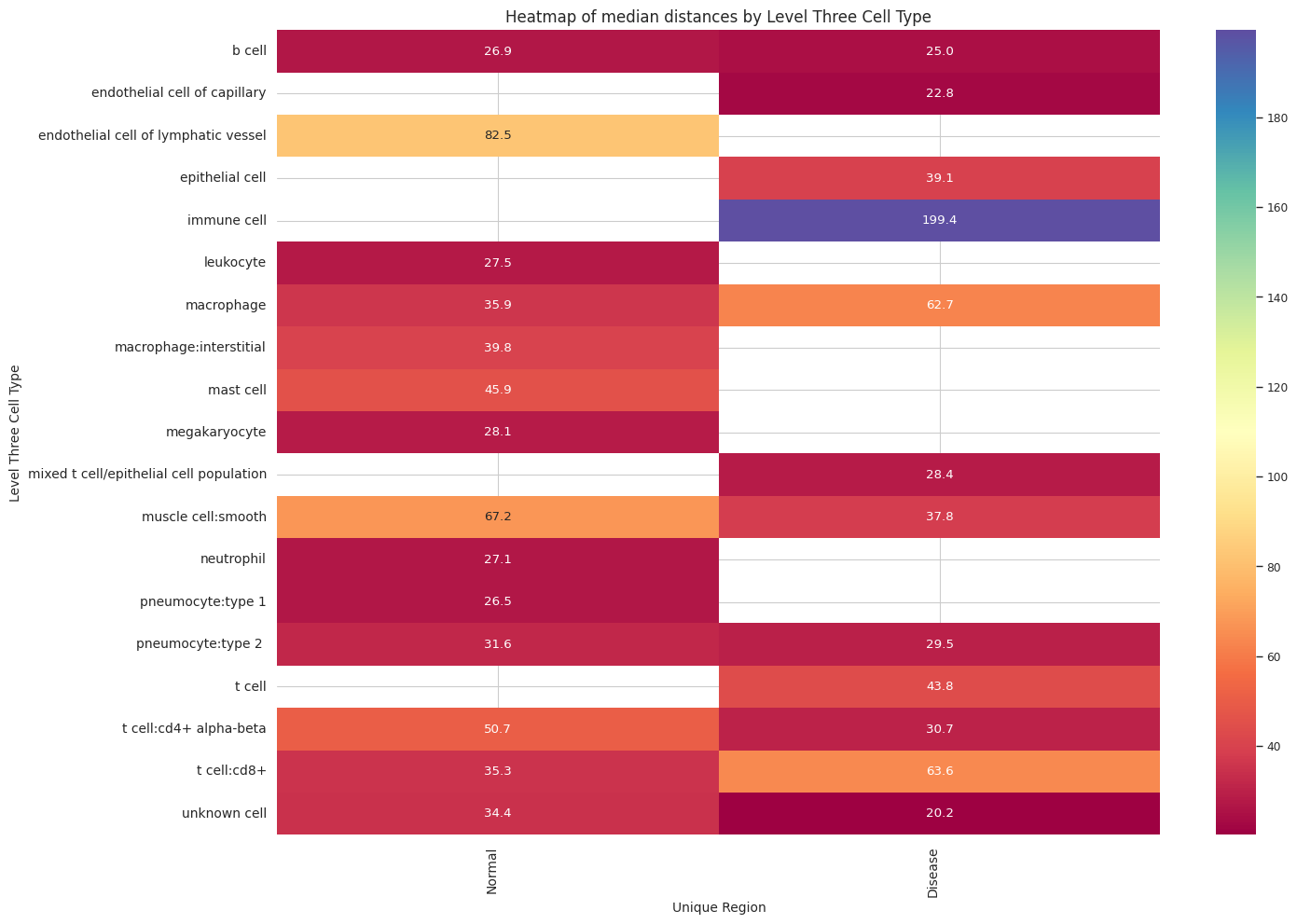
plot_violin_plots_all_regions(df_all_edges_with_cell_type_level, cell_type_level, os.path.join(basepath, figures_output_dir), density_norm="count") # Or, density_norm="count" or "area" based on preference.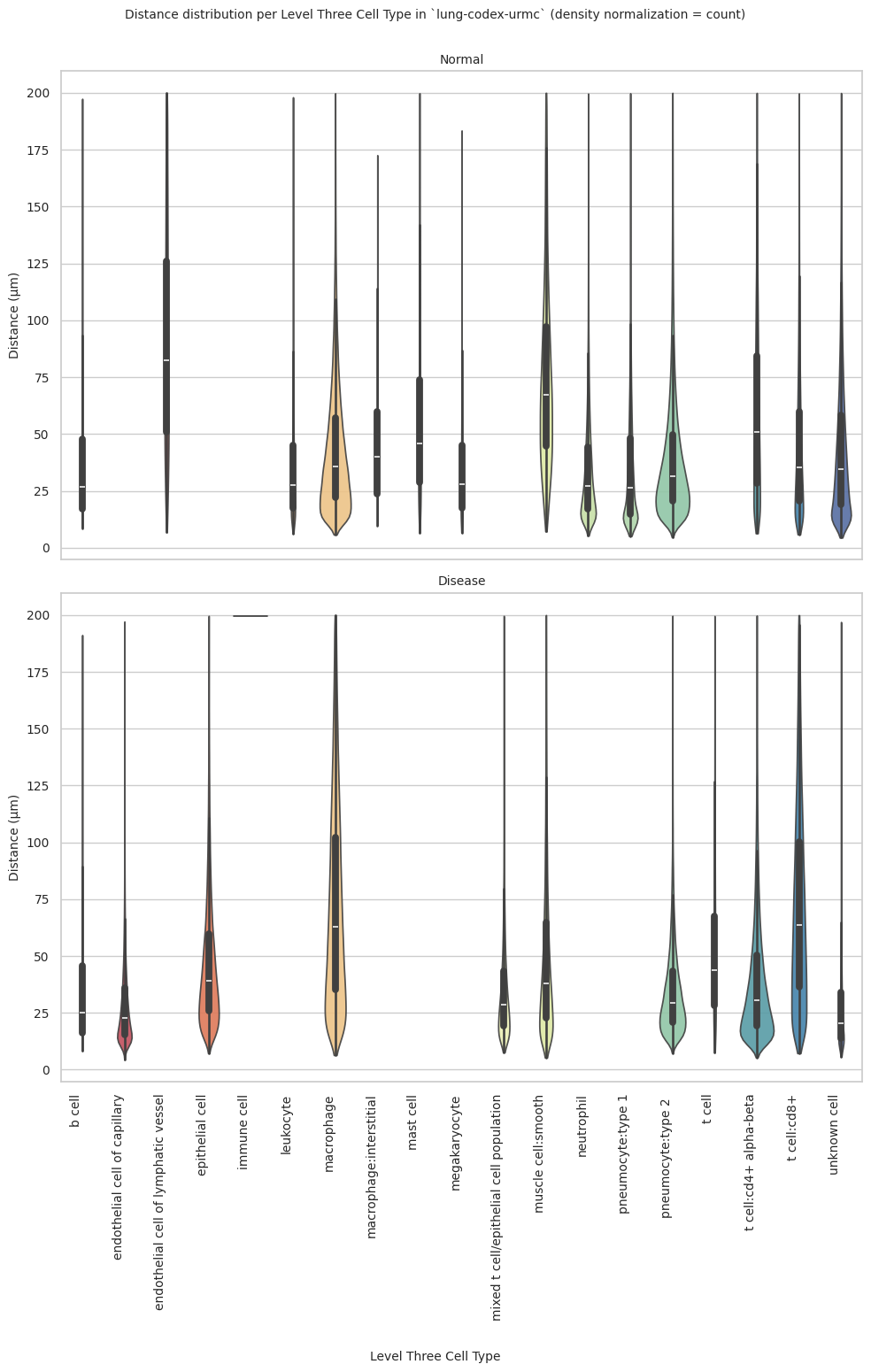
plot_violin_cells_per_celltype_split_by_condition(df_all_edges_with_cell_type_level, cell_type_level, os.path.join(basepath, figures_output_dir), density_norm="count") # density_norm="count" or "area" can be used based on preference.